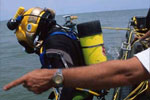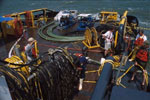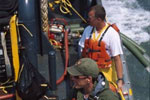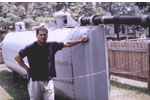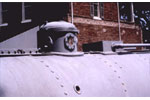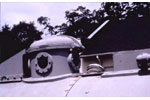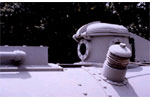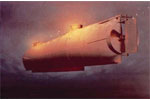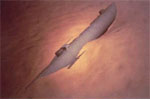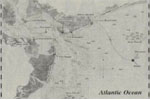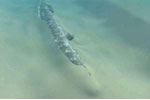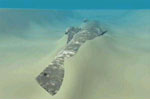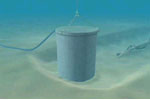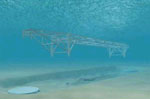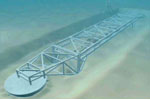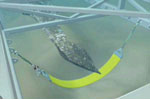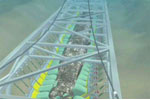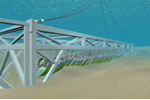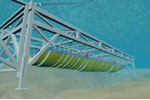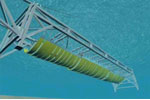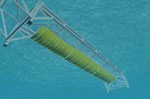Hunley (C.S.S.)
Search for the C.S.S. HUNLEY, the U.S.S. CUMBERLAND and the C.S.S. FLORIDA
By Clive Cussler (July, 1980)
Not content with looking for America’s most elusive shipwreck, I had to try for number two, which should indicate to those who don’t know me that my mind lies somewhere left of delirium and right of monomania.
The story of the Hunley has been told and retold many times since her disappearance in 1864. Constructed by the Confederacy in Mobile, she was later shipped to Charleston in an optimistic hope of breaking the Union blockade. Despite the fact she dispatched four of her crews, she was quite advanced for her time.
The Hunley took up the banner left by David Bushnell’s Turtle and blazed the trail for future underwater warfare by becoming the first submarine in history to sink a fighting ship during war. She gained her everlasting fame when her crew of nine propelled her out with the tide on the evening of February 17th, 1864, and laid her spar torpedo under the side of the new Union navy sloop-or-war, Housatonic.
Robert Fleming, a fine guy and one of our great maritime researchers came up with the lion’s share of the data. He went two steps past the other archivists and found the Naval Board of Inquiry record into the sinking of the Housatonic. The 115 pages were, of course, written in longhand and the wax seal was still unbroken on the folder.
Testimony by the ship’s deck officers indicated that the Confederate torpedo boat had backed off at least fifty feet and perhaps as far as a 100 after implanting her explosives into the aft starboard hull of the Housatonic. This suggests to me that she survived the blast and is not buried under or inside the remains of the Union ship.
Also, in November of 1864, Admiral Dahlgren ordered a survey of the wreck. The salvage officer reported that he had dragged the seabed for 500 yards around the Housatonic and found no trace of the torpedo boat.
Several salvage projects in the next forty years could not find the hulk of the Hunley either.
Oddly, the evidence that seems to be consistently ignored came from Lieutenant Colonel Dantzler, Commander of Battery Marshall, the fortification where the Hunley was based. Historians assumed he was trying to cover his tail for neglect with the following report.
‘I have the honor to report that the torpedo boat stationed at this post went out on the night of the 17th instant (Wednesday) has not yet returned. The signals agreed upon to be given in case the boat wished a light to be exposed at this post as a guide for its return were observed and answered. An earlier report would have been made of this matter, but the officer of the day for yesterday was under the impression that the boat had returned, and so informed me ….’
Therefore, our first expedition to Charleston to find the Hunley concentrated just off the beach line. From there, we worked out to sea about a mile before we had to break off the search attempt and head for Virginia.
Doc Edgerton came down with his side scan sonar and confirmed that anything that sank outside of Charleston Harbor quickly settled and was covered over by extremely soft silt. Our divers found they could easily push their arms into it up to their shoulders.
It came as no surprise when we discovered the remains of the Housatonic totally buried and quite scattered. Our divers extensively probed the debris area outside her boilers and found mostly shattered bits and pieces. No intellectual giant was required to conclude that the Hunley lies elsewhere under four to ten feet under the mud.
We used two boats for our preliminary, data finding search. Our smaller Zodiac with Bill Shea operating a proton magnetometer, Dirk Cussler at the steering arm of the outboard, and marine archaeologist Dan Koski-Karell taking the navigating chores, slipped over the bar at Breech Inlet and ran search lines up and down the surf line, moving out with each lane. Our second boat, a thirty-two footer with twin Chrysler engines called the Coastal Explorer, doubled as a search vessel and dive boat.
Forgive me for dwelling on the CE and her crew. The skipper, I beg his forgiveness for losing his name, was a really nice guy. His two crewmen, whom I referred to as Heckle and Jeckle, were students at Charleston’s Citadel academy and a genuine pair of Southern characters. Barnum, Bailey and the Ringling Bros. couldn’t have outshone the acts that took place on the Coastal Explorer.
The skipper’s parents screamed at each other nonstop twenty-four hours a day. The boat’s engines broke down like clockwork. We almost all died from the heat, humidity and flies. We struck the breakwater while trying to take a shortcut, holed the bottom and had to bail like madmen or we’d have gone down in the ship channel. Even Doc Edgerton jumped into the water with myself and the skipper to help shove her into deep water. We ran out of gas a hundred yards from the dock on two occasions. Peter Throckmorton and I fought on a regular basis. Karen Gestla, our resident psychic, sat entranced on the bow, doing a creditable job of predicting the weather but striking out on the Hunley’s location. Debbie Sharp, Wayne Gronquist’s girl friend, made quite a hit with the crew, sprawling her six foot, barely bikini clad body in front of the windshield so the helmsman could not see over the bow. Ralph Wilbanks, archaeologist with the University of South Carolina, also greatly added to the festivities with his down home dance routines.
However, strange as it seems, the expedition was efficiently carried out. The Housatonic was discovered and briefly surveyed, we also found the dual-turreted citadel ironclad, Keokuk, and the monitor, Weehawken, with our trusty Schonstedt gradiometer.
Our shoreline crew did not go home dry either. They discovered the Confederate blockade runner, Rattlesnake, that had run aground off Breech Inlet. But their greatest triumph was saving the lives of three children who were swept out to sea in a tidal current. If Bill, Dan and Dirk had not been nearby when the mother and people on shore frantically screamed, the children would have surely drowned.
So, though we didn’t come close to finding the Hunley, the sites of four historic shipwrecks were discovered and three children are walking around today who came within thirty seconds of receiving premature funerals.
Note: Location and survey details on our wreck discoveries will be covered in the next section, the June 1981 report on NUMA’s Siege of Charleston expedition.
After wrapping up the Charleston end of the expedition, we bid the Skipper, Heckle and Jeckle, and the Coastal Explorer a fond farewell, packed up our equipment and headed for Norfolk, Virginia, where we intended to check out the possibility of a later expedition to find the famous Confederate sea raider, Florida, and the Union frigate, Cumberland, which was sunk by the Merrimack, or Virginia as it was known to the South.
Derek Goodwin, our esteemed Washington correspondent and his talented wife, Susan, had arranged for a large, nineteen-twenties built yacht to carry us up and down the James River to look for the two Civil War ships, resting in unknown graves on the mud just off Newport News, Virginia.
I realized this sounds farfetched, but the crew of the Sekonit, as the long, narrow old yacht was called, were as dingy as the last batch. Somehow the events fog before my eyes. All I can remember was sleeping in a cabin the size of a dollhouse closet and lying awake all night listening to my sweat drip. God, was it humid. Bill Shea, Walt Schob and my son Dirk had the good sense to stay in a Holiday Inn. My only salvation were the evenings spent dining and drinking on the large canvas covered deck.
The Virginia state archaeologist, John Broadwater, showed up with his assistants, Mike Warner, Dick Swete, Sam Margolin and Jim Knickerbocker, who would later leave the state and form their own marine survey company.
For the next four days we swept back and forth parallel to the piers and shipyard. We hit several targets, but one that especially suggested the boilers of the Florida. Walt Schob and the archaeologists dove and found a wreck which indeed later proved to be the Florida. A few artifacts were brought up, but because of stupid state laws Broadwater threw them back in the river.
My wife, Barbara, and I had to leave at this stage and fly to Boston for the premiere of the motion picture based on my book “Raise the Titanic”. As the old saying goes, ‘I shudda stayed in bed.’ The movie was a disaster, particularly at the box office. But that’s another story.
We wrapped our combination Charleston/Norfolk project of 1980 and headed home, already planning for NUMA’s next adventure in Charleston and another attempt at the Hunley.
Third and Final Search for C.S.S. HUNLEY
by Clive Cussler (May, 1995)
The Hunley found. Third and final search for the Confederate submarine C.S.S. Hunley. June, 1994 through May, 1995.
I decided to make another attempt to find the elusive sub during the month of June in the late spring of ’94. After contacting the South Carolina Institute of Archaeology and Anthropology, I was talked making it a joint venture with the institute under the direction of Mark Newell, who I had corresponded with off and on during the years. Not a sound idea. The plan was for NUMA do survey for targets and then turn them over to the Institute dive team for identification.
After sending faithful Lieutenant Walt Schob ahead to line up lodging and a survey crew, my son Dirk, Craig Dirgo arrived and immediately drove to the dock where we renewed old acquaintances with Bill Shea and Ralph Wilbanks who was in charge of the survey. Ralph had long since left the institute and formed his own underwater survey company called Diversity Survey. Having a fine, solid boat, a proton magnetometer, a Klein sonar and the latest in satellite positioning systems, Ralph, along with his associate Wes Hall, a veteran marine archaeologist who headed up Mid-Atlantic Technology, set out to mark the targets found during the 1981 survey and buoy them for the Institute divers to identify.
This latter phase of the project was a fiasco to say the least. The divers, most of them sport divers who paid Mark Newell for the privilege of joining the hunt, hardly performed to 530 expectations. Those of us in the survey boat had to constantly interrupt our line runs to remark the targets as the institute never seemed to get the hang of pinpointing the target with an underwater mag. I could go on in greater detail, but why muddy the water of a great achievement.
After eliminating the ’81 targets and searching new ground without tangible results, we folded the operation and went home. But I was too dogged to give up. I contracted with Ralph and Wes to keep the search going when their time permitted.
During the next eleven months, Ralph ran lines totaling 796 miles. I would fax him search grids which he scoured. Upon announcing them empty, I would send him new ground to cover. Finally, after exhausting most of the area from the jetty east and between the Housatonic and Breech Inlet, Ralph decided to head back to the Housatonic site and work out to sea.
A thousand feet southeast of the Housatonic’s boiler, Ralph, Wes Hall, and diver/archaeologist Harry Pecorelli struck a 650 gamma target that had somehow been overlooked during previous searches. Pecorelli went down and probed the silt since no object was protruding above the sea floor. The object was long and narrow. Then Wes Hall went down with a three inch dredge and sucked away two feet of the silt. Fortune smiled as Wes peered through the murk and drifting sand into the excavated hole and recognized the hatch cover of the Hunley.
Excitement quickly raising to a fever pitch, the three men uncovered a small portion of the wreck, finding that it lay thirty degrees on its starboard side. The entire entrance tower, the snorkel box and the port diving plane were now visible. One of the quartz lenses was missing from the tower and by inserting their hands they determined the sub was filled with silt, which until the sub is raised indicates the possibility the bones of the crew may still be preserved.
The crew then returned to shore and studied the Hunley replica at the History Museum of Charleston, enjoying the fact at that moment they were the only three men in the world who knew the differences between the real sub and the facsimile. They then phoned me with the news of the discovery.
I directed them to take photos of the wreck so we could authenticate our claim. Ralph took video of the excavated sections through the murk that proved more than sufficient to establish credibility. At a news conference three days later, the video was given to the news media and ran internationally on television news programs for the next two or three days.
Then the fun began as to who would take control of the sub, who would own it and who would direct the salvage and preservation.
But that’s another story I won’t bore you with here. At this writing (6-1-95) I can only hope the venerable old Peripatetic Coffin and her crew are saved, conserved and enshrined in a proper setting, preferably in Charleston where her legend was born.
Hunley Resurfaces
By J. A. Hitchcock
She’s smaller than originally thought, and her bow is curved, not square. These are among the first mysteries solved by the raising of the Civil War submarine H. L. Hunley after 136 years on the bottom of Charleston Harbor. To commemorate the occasion, maritime artist Marek Sarba depicts her final departure, with Confederate General P. G. T. Beauregard among the observers. Sarba has produced a limited-edition print of this spectacular painting, the sales of which will benefit the efforts to preserve the Hunley.
Dateline: 17 February 1864, Charleston Harbor, South Carolina, 2000-The USS Housatonic rests at anchor, her bow facing west by northwest toward Fort Sumter. Those on deck keep watch for a newfangled contraption that could travel underwater. The night is clear and moonlit, the seas calm. Suddenly, at 2045, Officer of the Deck John Crosby spots an anomaly in the water, “what looked to be a porpoise coming to the surface to blow.”
But it is not a porpoise, it is the H. L. Hunley. Even as bullets ricochet off the hull of this iron fish, she moves forward quickly-straight for the Housatonic.
Minutes later, an explosion rocks the Housatonic, and she begins to sink fast. Men clamber over the side, into the water and into launches that have been cleared from the ship. One is sent to the nearby Canandaigua to summon assistance.
Later, Federal Seaman Robert Fleming testifies: “When the Canandaigua got astern, and was lying athwart of the Housatonic, about four ship lengths off, while I was in the fore rigging, I saw a blue light on the water just ahead of the Canandaigua, and on the starboard quarter of the Housatonic.” This was the pre-arranged signal the submarine’s crewmen were to give to let those on shore know she was safe.
But the Hunley never made it back to port.
6 August 2000, Conservation Laboratory, Charleston, South Carolina
Underwater explorer and best-selling author Clive Cussler and his companions stand in front of what looks like just another nondescript warehouse at the old Charleston Naval Shipyard. They are met outside by Paul Mardikian, Senior Conservator, and Dr. Robert Neyland, Project Manager. This is the lab where the Hunley will be brought for conservation and restoration.
As they are led inside and up a flight of metal stairs painted yellow, they face a large, green holding tank-the future home of the Hunley, possibly for the next ten years.
Mardikian patiently explains what will happen after the Hunley arrives at the lab:
The first step is to fill the tank with chilly water, once the submarine is put in. When everything inside the submarine has been excavated [estimated time 6-12 months], remains and artifacts will be properly stored, then conservation of the sub itself begins. As it’s made entirely out of iron, we have concretions on the outside to deal with, possibly some rust, maybe some organic creatures, which makes it a very complex project, and can take anywhere from five to ten years, and that’s a general timeline. You cannot reverse 136 years of corrosion quickly.I’ve worked on the Titanic, the Alabama, and ancient shipwrecks, and I can tell you it is very rare to have a complete shipwreck with no oxygen, like the Hunley. Once we get inside the submarine, we will be able to tell how much, if any, oxygen has been in there and if it affected any of the artifacts. So we need to be ready for every option. There is no room for guessing at this point if there are any significant remains of the crew, if there is any organic material, like textiles. Some people will say everything will be gone, but we just don’t know.
The group is led to a computer work station, waterproofed because of its proximity to the tank. A program on the computer allows the scientists and archaeologists to monitor everything involved with the tank, including the rate of oxygen, conductivity of the water, and Ph levels. Each of the three water tanks outside the building can be opened or closed, or the computer can regulate water moving in and out of the inside tank.
A refrigerated morgue on the ground level has nine steel trays, each the length of a human body, waiting for whatever is found inside the submarine. Another computer is set up just outside the morgue, connected to a large X-ray machine that will be used not only for any human remains found, but also on various parts of the submarine. The spar, which held the explosive that destroyed the Housatonic, still was attached to the bottom of the bow of the Hunley. It had to be removed for proper recovery of the submarine and was one of the first artifacts brought to the lab. Mardikian shows the group an X-ray of the spar, pointing out the layer of concretion on the outside and how the computer software can show the spar without the concretion, which will help them during restoration. “We’ve found in ancient shipwrecks that iron disappears, but the concretions become like molds. So some parts of the spar might be completely empty, even though the corrosion rate is not very high,” Mardikian explains.
The group walks upstairs to the offices and stops in front of a model of the Hunley, strapped into a metal truss and covered with what looks like yellow pillows. Neyland steps forward and points at the model.
We went through a number of ideas to raise the submarine when we began planning this three years ago. We looked at a coffer dam, which would have been very expensive. We looked at going down and scooping up the whole wreck in a great big clamshell, but found the soil around the Hunley wouldn’t support that. Finally, we looked at a space frame, what we call a truss. Then we figured that the Hunley, filled with sand, weighs about 30 tons. So if we just put the truss down, then transferred the weight of the Hunley to the truss, it would have sunk into the mud. So we came up with a method that was used in the Gulf of Mexico, these great big suction piles, which are essentially inverted cans that go in the bottom, then pump out the water so they suck down. These acted as an excellent stable foundation, 18 feet in diameter, 12 feet high and weigh about 45 tons.We originally thought we could put a couple of slings here and there [on each end of the sub], but last year we looked at the rivets on the sub and found they were highly corroded. In fact, one of the rivets just punched right through. If we took the sediment away, the sub could basically unzip and come apart. So we found we had to leave it in the sediment, then replace the sediment gradually, one sling at a time, until we had all the slings on board.
“You didn’t take my suggestion to wrap it all in duct tape,” Cussler says dryly, and everyone laughs. Neyland continues:
We found three holes in the hull, the first in the conning tower, which may have been from gun shots or small arms’ fire. We found the second on the starboard side, up by the bow and a hole back in the stern area. So we attached bags to the slings and injected them with hard foam around the hull to protect it. We looked at using hard rubber, but some folks at a division of Dow Chemical said they had this foam, although they’d never used it under water. We took it to a facility in Louisiana that has a 30-foot tank and tested it. It’s incredible stuff. After this is over, it’s possible the Navy will begin using it-they’ve been looking for something like this for years for salvage. As the foam was injected in, the water in the bags ejected through the seams.
Later, Cussler relates, “I think what I like best about the lab is that they’re going to make it a world-class lab, not just for the Hunley. So many times you bring up artifacts and there’s no way to conserve them, so you throw them back. Now they can have all sorts of artifacts coming in from all over the United States to be conserved.”
8 August 2000, Charleston Harbor, 0430
The Land Rover speeds into a dirt parking lot and Clive Cussler climbs out. It is still pitch dark. Cheerfully, he walks toward the dock, where a charter boat waits for him and the media. He is to spend the day on the press boat. Wearing a NUMA (National Underwater and Marine Agency) t-shirt and hat, Cussler and his companions climb to the second deck and settle in. None of the media takes notice. This amuses Cussler to a degree; he could go just about anywhere unnoticed, but today of all days, surely someone will know who he is and why he is there.
A little bit after 0500, the boat heads out, passing the aircraft carrier Yorktown (CVS-10) and Fort Sumter. Lights twinkle in the distance and as the boat gets closer, the platform of the Karlissa-B comes into view. A 51.7-meter by 24.4-meter, six-leg barge, equipped with DeLong jacks and a 318-metric-ton Manitowoc platform ringer crane, the Karlissa-B will be bringing up the Hunley later in the morning.
As the press boat floats into place near the Karlissa-B, Cussler watches the scene with tired but excited eyes. Never in his wildest dreams did he think he would see the Hunley raised in his lifetime. Yet in five short years, after his NUMA team discovered the submarine on 3 May 1995, the dream was now becoming a reality.
8 August 2000, Charleston Harbor, 0830
The water around the Karlissa-B, the recovery barge, and the press boat swarm with vessels of all descriptions, hundreds of them, some circling the area, others waiting patiently. The Hunley should have been raised a half-hour earlier, but strong winds forced the recovery team to bring in a large barge to settle the area.
At 0839, the Hunley breaks the surface of the water. It is still silent. As the Hunley is lowered gently to the recovery barge, boat horns toot and blast. People cheer wildly. Cannon are fired from shore in celebration.
“I’m numb-just numb,” says Cussler, as his eyes watch the Hunley. “Everybody assured me this would go like clockwork, and it did!”
At that moment, it seems the media finally realize who Cussler is. He is surrounded with microphones. Says the well-known novelist:
It’s much smaller than I thought it was. Everyone thought it would be much larger. And there were so many misconceptions about what we thought the sub looked like. We thought it had a big, square bow, and it doesn’t. It actually curves. We thought it was 36-feet long, and 3 by 5 feet. It’s only 32-feet long and 3 by 4 feet. Now they’re saying the guys in it couldn’t have been more than five-foot-two. The technology at that time was incredibly advanced. This set the foundation for all future submarines. What made me keep looking for it? I was convinced it was here, and by God, it was here!
The press boat keeps pace with the recovery barge as it is towed to the conservation lab by two tugboats. Hundreds of other boats follow, horns blasting every once in a while. As they pass Fort Sumter, the fort’s flag is at half mast and cannon are fired. They pass Fort Moultrie, and men in Civil War uniform render a 21-gun salute. They pass the Yorktown, and military men and women stand at attention. Church bells begin ringing on shore, one after another.
After 136 years, the Hunley and her crew of nine finally have come home.
The C.S.S. Hunley Returns Home
August 13, 2000
Author/adventurer Clive Cussler and his NUMA Crew who found the Hunley, May 3, 1995, watched proudly as a team of archaeologists lifted the Civil War submarine August 8, 2000 four miles off the coast of Charleston, SC.
PHOENIX, AZ-Tuesday, August 8, was an emotional day for many Americans as the CSS Hunley, the first submarine to sink a ship in battle, was retrieved from the watery grave to which she plunged February 17, 1864. For 15 years, novelist and adventurer Clive Cussler and divers from his 501C3 National Underwater and Marine Agency (NUMA) searched for the elusive CSS Hunley. Cussler’s team, including Ralph Wilbanks, Wes Hall and Harry Pecorelli, found the sub May 3, 1995. The Hunley was buried under three feet of silt in 28 feet of water four miles outside Charleston, SC. Cussler invested more than $130,000 to locate the historic vessel.
“I did not think this would happen in my lifetime,” Cussler remarked to a group of journalists covering the historic event.
After watching the Hunley safely placed on the barge that would transport her to the Warren Lasch Conservation Center, Cussler told the reporters, “Well, I have to be going now.” With that, the 69-year-old best-selling author jumped off the Carolina Clipper Press Boat and did the backstroke to the Diversity, Wilbanks boat that was used when the Hunley was discovered.
H.L. Hunley, a submersible known as the “South’s secret weapon,” had just turned for shore after signaling it had succeeded in sinking the Union blockader USS Housatonic (also located by Cussler and NUMA) the night of February 17, 1864, when it vanished with all hands. The fate of the Hunley and her nine young volunteer crewmen remained a mystery for more than 131 years until Cussler and his NUMA crew discovered her.
The discovery has been hailed as the American maritime historical discovery of the century. Doctor Robert Neyland, the Naval Historical Center’s (NHC) chief underwater archaeologist and Hunley project director called the revolutionary vessel “a national treasure” comparable to the Wright brothers’ aircraft. Cussler believes that because the submarine filled with silt so quickly the bones of the crew might still survive.
“In many ways this is like recovering a bottle — everything is contained inside the submarine,” Neyland said. “It is the very first successful military submarine. Not until World War I would another submarine sink an enemy ship.”
Cussler donated $50,000 to the Friends of the Hunley to help raise the Hunley. Video of an artist’s rendering of the raising is available for viewing on the NUMA web site: www.numa.net
HUNLEY COMPLETES THE JOURNEY: RETURNS TO CHARLESTON AFTER 136 YEARS
Raising the Hunley took on a festive air as nearly 200 pleasure craft turned out to accompany the submarine home. An American flag at Ft. Sumter flew at half-mast as the barge carrying the submarine passed by. Many of the boats surrounding the Hunley had Confederate and US flags flying.
Now the process of preserving the submarine and excavating the remains begins, a process that scientists say may take five to ten years.
For Cussler and NUMA it’s back to other pursuits although the author says he may return to Charleston in the fall when the remains of the nine sailors are interred at Magnolia Cemetery. The remains will be buried alongside the first two crews of the Hunley. A total of 22 men gave their lives to bring submarine warfare to life.
For additional information on the preservation and conservation efforts surrounding the Hunley, please check the Hunley web site: www.hunley.org
Raising the Hunley Gets Closer
July 6, 2000
Author/adventurer Clive Cussler and his NUMA Crew will be on hand August 7, 2000 for raising of the first submarine to sink a ship in battle located by NUMA May 3, 1995
PHOENIX, AZ-For 15 years, novelist and adventurer Clive Cussler and divers from his 501C3 National Underwater and Marine Agency (NUMA) searched for the elusive CSS Hunley, the first submarine to sink a ship in battle, which had disappeared February 17, 1864. Cussler’s team found the sub May 3, 1995. The Hunley was buried under three feet of silt in 28 feet of water four miles outside Charleston, SC. The NUMA crew ran 1159 miles of grid lines to discover the Hunley. A team led by the National Park Service Submerged Cultural Resources Unit surveyed the wreck in 1996 to determine if the submarine could be recovered. Cussler invested more than $130,000 to locate the historic vessel.
H.L. Hunley, a submersible known as the “South’s secret weapon,” had just turned for shore after signaling it had succeeded in sinking the Union blockader USS Housatonic the night of February 17, 1864, when it vanished with all hands. The fate of the Hunley and her nine young volunteer crewmen remained a mystery for more than 131 years until Cussler and his NUMA crew discovered her.
The discovery has been hailed as the American maritime historical discovery of the century. Doctor Robert Neyland, the Naval Historical Center’s (NHC) chief underwater archaeologist and Hunley project director called the revolutionary vessel “a national treasure” comparable to the Wright brothers’ aircraft. With the exception of a hole in the forward hatch, the Hunley was found intact. It is believed the submarine was quickly covered and filled with sediment. Cussler believes that because the submarine is filled with silt that the bones of the crew might still survive.
“In many ways this is like recovering a bottle — everything is contained inside the submarine,” Neyland said. “It is the very first successful military submarine. Not until World War I would another submarine sink an enemy ship.”
A spar used to sink the Housatonic was retrieved June 13 and is the first artifact from the Hunley brought back to shore. Cussler donated $50,000 to the Hunley Commission to help raise the Hunley. Video of an artist’s rendering of the raising is available for viewing on the NUMA web site: www.numa.net
The wreck weighs approximately eight tons with sediment inside and will be raised at an angle to keep it from breaking up. Exactly why the Hunley sank is not known. It’s a question that may be answered when the craft is raised.
Recovery of the ship’s spar last month intrigued scientists who discovered that the device could be tilted – evidence the submarine was more technologically advanced than first thought. The spar is about 16 feet and 4 inches long and weighs approximately 200 pounds with a hinge at one end. The spar was in two parts – an approximate two-foot section near the front was discovered broken off. A thinner iron rod was discovered near it that might have been used to support the spar, scientists said. Historical accounts indicated the Hunley had a wooden spar attached to the top of the bow. Now scientists have learned that the spar was made of iron, was located near the bottom of the bow and could be tilted.
Neyland said tilting the spar would have allowed the crews to more easily put powder charges on the end. It could have also been used to better aim the charge when the Hunley rammed a vessel, he said.
Cussler, who refused to give up after years of frustration, funded the search with his book royalties. His persistence finally paid off when his search team, led by archaeologists Ralph Wilbanks and Wes Hall, discovered a magnetic anomaly in an area where The Hunley was not supposed to be. After probing the silt and finding an object of the approximate dimensions of the submarine, Wilbanks and Hall then dredged through the silt until they uncovered the forward hatch and one of the diving stabilizers. Stunned by the spectacular discovery, they called Cussler at 4:00 in the morning. When Wilbanks informed the author they were not going to look for The Hunley anymore, Cussler asked him if they were giving up.
“No,” Wilbanks responded. “We found it.”
Then it was Cussler’s turn to be stunned. “I walked around numb for two days,” he
reported. “Too bad P.T. Barnum isn’t still alive. Back in 1879, he offered a hundred thousand dollars to anyone who could find and raise the Hunley for display in his New York Museum.”
To dispel any rumors that it was Cussler and his NUMA team that found the sub after it vanished 131 years earlier, a plastic NUMA letterhead wrapped in baggies and signed by Cussler, Wilbanks and Hall was inserted through a broken port. The NUMA letterhead read, “Today, May 3, 1995, one hundred thirty one years and seventy five days after your sinking. Veni, Vidi, Vici! Dude.”
There was no profit in finding the famous submarine. The only treasure was historical. Cussler received nothing for his years of dedication but satisfaction. He turned the coordinates of the sub’s position over to the U.S. Navy.
In The Sea Hunters, Cussler’s first best-selling non-fiction the author describes the history of the first successful submarine. “R30;The Hunley began life as a locomotive boiler in Mobile, AL. The craft was named for its inventor and primary financial backer, Horace L. Hunley…The craft was amazingly advanced for her time. Her hull configuration was very similar to the much later Nautilus nuclear sub designs. She had diving planes attached on each side of the hull, manual pumps to increase or decrease water ballast, a single propeller and rudder protruding from the center of the stern, again much like a modern nuclear submarine. Iron weights on the keel could be dropped with the twist of a wrench to decrease ballast during emergencies. Two small raised openings with viewing ports served as entry and exit hatch towers…There was even a rudimentary snorkel system, called an air box, with pipes that could swing vertical, their ends above the water surface. It was almost as if Henry Ford had built a 1929 Model A sedan on his first attempt at a horseless carriage. The Hunley’s only shortcoming was her primitive propulsion system…She had to rely on eight strong men to turn the crank that rotated her propeller…”
Internationally acclaimed as the Grand Master of the American action/adventure novel best-selling author Cussler, who earned his Ph.D., in Maritime History from the Maritime College, State University of New York for THE SEA HUNTERS is active in NUMA research. He is founder and Chairman of the Board of NUMA; a 501C3 Agency headquartered in Austin. NUMA is responsible for finding more than 80 missing ships and planes of historical significance throughout the world. For more information about NUMA or to donate to the charity, visit the NUMA web site: www.numa.net Cussler’s next novel, BLUE GOLD from the NUMA Files is due out August 1st.
Raising the Hunley
July 27, 2000
U.S. Navy credits Clive Cussler and his NUMA Crew with locating first submarine to sink a ship in history
PHOENIX, AZ-Last week the Naval Wire Service released a story crediting novelist and adventurer Clive Cussler and divers from his non-profit National Underwater and Marine Agency (NUMA) with locating the CSS Hunley, the first submarine to sink a ship in battle. Cussler’s team found the elusive sub May 3, 1995. The Hunley was found under three feet of silt in 28 feet of water four miles outside Charleston, SC. The NUMA crew ran 1159 miles of grid lines to discover the Hunley. A team led by the National Park Service Submerged Cultural Resources Unit surveyed the wreck in 1996 to determine if the submarine could be recovered. Cussler and his NUMA crew discovered the Hunley after 15 years of searching and an investment by Cussler of more than $130,000.
H.L. Hunley, a submersible known as the “South’s secret weapon,” had just turned for shore after signaling it had succeeded in sinking the Union blockader USS Housatonic the night of February 17, 1864, when it vanished in Charleston Harbor, SC with all hands. The fate of the Hunley and her nine young volunteer crewmen remained a mystery for more than 131 years until Cussler and his NUMA crew discovered her.
The discovery has been hailed as the American maritime historical discovery of the century. Doctor Robert Neyland, the Naval Historical Center’s (NHC) chief underwater archaeologist and Hunley project director called the revolutionary vessel “a national treasure” comparable to the Wright brothers’ aircraft. With the exception of a hole in the forward hatch, the Hunley was found intact. It is believed the submarine was quickly covered and filled with sediment. Cussler believes that because the submarine is filled with silt that the bones of the crew might still survive.
“In many ways this is like recovering a bottle — everything is contained inside the submarine,” Neyland said. “It is the very first successful military submarine. Not until World War I would another submarine sink an enemy ship.”
A spar used to sink the Housatonic was retrieved June 13 and is the first artifact from the Hunley brought back to shore. Officials hope to raise the submarine itself by early August. Cussler donated $50,000 to the Hunley Commission to help raise the Hunley.
The wreck weighs approximately eight tons with sediment inside and will be raised at an angle to keep it from breaking up. Exactly why the Hunley sank is not known. It’s a question that may be answered when the craft is raised.
Recovery of the ship’s spar last month intrigued scientists who discovered that the device could be tilted – evidence the submarine was more technologically advanced than first thought. The spar is about 16 feet and 4 inches long and weighs approximately 200 pounds with a hinge at one end. The spar was in two parts – an approximate two-foot section near the front was discovered broken off. A thinner iron rod was discovered near it that might have been used to support the spar, scientists said. Historical accounts indicated the Hunley had a wooden spar attached to the top of the bow. Now scientists have learned that the spar was made of iron, was located near the bottom of the bow and could be tilted.
Neyland said tilting the spar would have allowed the crews to more easily put powder charges on the end. It could have also been used to better aim the charge when the Hunley rammed a vessel, he said.
The hand-cranked Hunley, built with locomotive boilers, sank off Sullivan’s Island with its crew Feb. 17, 1864, after ramming a black powder charge at the end of a spar into the wooden hull of the Union blockade ship Housatonic. (Note: Clive Cussler and NUMA also located the Housatonic) In so doing, the Hunley became the first submarine in history to sink an enemy warship. The spar ushered in submarine warfare.
Cussler, who refused to give up after years of frustration, funded the search with his book royalties. His persistence finally paid off when his search team, led by archaeologists Ralph Wilbanks and Wes Hall, discovered a magnetic anomaly in an area where The Hunley was not supposed to be. After probing the silt and finding an object of the approximate dimensions of the submarine, Wilbanks and Hall then dredged through the silt until they uncovered the forward hatch and one of the diving stabilizers. Stunned by the spectacular discovery, they called Cussler at 4:00 in the morning. When Wilbanks informed the author they were not going to look for The Hunley anymore, Cussler asked him if they were giving up.
“No,” Wilbanks responded. “We found it.”
Then it was Cussler’s turn to be stunned. “I walked around numb for two days,” he reported. “Too bad P.T. Barnum isn’t still alive. Back in 1879, he offered a hundred thousand dollars to anyone who could find and raise the Hunley for display in his New York Museum.”
To dispel any rumors that it was Cussler and his NUMA team that found the sub after it vanished 131 years earlier, a plastic NUMA letterhead wrapped in baggies and signed by Cussler, Wilbanks and Hall was inserted through a broken port. The NUMA letterhead read, “Today, May 3, 1995, one hundred thirty one years and seventy five days after your sinking. Veni, Vidi, Vici! Dude.”
There was no profit in finding the famous submarine. The only treasure was historical. Cussler received nothing for his years of dedication but satisfaction. He turned the coordinates of the sub’s position over to the U.S. Navy.
In The Sea Hunters, Cussler’s first best-selling non-fiction the author describes the history of the first successful submarine. “…The Hunley began life as a locomotive boiler in Mobile, AL. The craft was named for its inventor and primary financial backer, Horace L. Hunley…The craft was amazingly advanced for her time. Her hull configuration was very similar to the much later Nautilus nuclear sub designs. She had diving planes attached on each side of the hull, manual pumps to increase or decrease water ballast, a single propeller and rudder protruding from the center of the stern, again much like a modern nuclear submarine. Iron weights on the keel could be dropped with the twist of a wrench to decrease ballast during emergencies. Two small raised openings with viewing ports served as entry and exit hatch towers…There was even a rudimentary snorkel system, called an air box, with pipes that could swing vertical, their ends above the water surface. It was almost as if Henry Ford had built a 1929 Model A sedan on his first attempt at a horseless carriage. The Hunley’s only shortcoming was her primitive propulsion system…She had to rely on eight strong men to turn the crank that rotated her propeller…”
Internationally acclaimed as the Grand Master of the American action/adventure novel best-selling author Cussler, who earned his Doctor of Letters from the Maritime College, State University of New York for THE SEA HUNTERS is active in NUMA research. He is founder and Chairman of the Board of NUMA; a 501C3 Agency headquartered in Houston. NUMA is responsible for finding more than 80 missing ships and planes of historical significance throughout the world.
Navy Credits Clive Cussler with Locating Hunley
by the Naval Historical Center
United States Navy Website Credits Clive Cussler with Locating the H. L. Hunley, First Submarine to Sink a Ship in Battle
WASHINGTON (NWS) — H.L. Hunley, a submersible known as the “South’s secret weapon,” had just turned for shore after sinking the Union blockader USS Housatonic one chilly February night in 1864, when it vanished in Charleston Harbor, S.C., with all hands. The fate of the first submarine to sink an enemy vessel in combat and her nine young volunteer crewmen remained a mystery for nearly 135 years, until a team led by the Naval Historical Center (NHC) in Washington, D.C., provided some answers.
Doctor Robert Neyland, NHC’s chief underwater archaeologist and Hunley project director, called the revolutionary vessel “a national treasure” comparable to the Wright brothers’ aircraft. “It is the very first successful military submarine,” he said. “Not until World War I would another submarine sink an enemy ship.”
Novelist and adventurer Clive Cussler and divers from his non-profit National Underwater and Marine Agency found Hunley in 1995.
A team led by the National Park Service Submerged Cultural Resources Unit surveyed the wreck in 1996 to determine if the submarine could be recovered.
In 1999, a team led by Neyland surveyed the wreck of USS Housatonic, confirming that while over 200 feet of the vessel remains, the starboard stern, the area reportedly hit by Hunley, is missing.
With the exception of a hole in the forward hatch, the Hunley was found intact. It is believed the submarine was quickly covered and filled with sediment.
“In many ways this is like recovering a bottle — everything is contained inside the submarine,” Neyland said.
In mid-May, a team of experts working in zero visibility began work to raise Hunley from the sea bottom, where it lies completely buried under three-to-four feet of sand and shells.
When the recovery, excavation, and conservation of Hunley are complete, Hunley will be on display at South Carolina’s Charleston Museum in a new wing built especially for the vessel and its associated artifacts.
To learn more about Hunley and other aspects of naval history, go to http://www.history.navy.mil.
by NAVY WIRE SERVICE (NWS) – June 27, 2000. NWS is an information product of the U.S. Navy and is published by the Naval Media Center, Naval District Washington Anacostia Annex, 2713 Mitscher Rd. SW, Washington, DC, 20373-5819.
Search for the Hunley
by Bob Browing and Wilson West
1981 Survey: A Paper Presented to the Thirteenth Conference on Underwater Archaeology
Introduction
The primary purpose of the National Underwater and Marine Agency (NUMA) is to help preserve America’s maritime heritage by locating and identifying historically significant shipwrecks. In June 1981, in conjunction with the Institute of Archaeology and Anthropology of the University of South Carolina, NUMA conducted a survey to locate and identify the remains of the Confederate submarine Hunley. The Hunley sank the U.S.S. Housatonic off Charleston Harbor, South Carolina in 1864, becoming the first submarine to sink an enemy vessel of war.
In 1863 James McClintock, Baxter Watson and Horace L. Hunley began work in Mobile, Alabama on a submersible vessel which they hoped would be used to break the Union blockade of the South. With the help of two army engineers, Lt. George Dixon and Lt. William Alexander, they constructed the submarine from an iron boiler twenty-five feet long. To increase the interior dimensions, the builders cut the boiler in half lengthwise and a foot strip of iron plate inserted, giving the vessel a more oval shape. Two wedge-like ends were added fore and aft, making its final dimensions thirty-five feet long, five feet high and four feet wide.
By design, the sub could be lowered and raised using water-ballast tanks at the bow and stern. Sea cocks and force pumps were installed to facilitate this procedure. The crew propelled the. sub by a hand crank which ran the length of the vessel and connected to a two-bladed propeller. The vessel could obtain a speed of four to five knots in calm water.
Conning towers were installed fore and aft for the purpose of boarding, The eight crew members sat in alternating spaces in the center of the vessel, facing one another. The skipper was positioned forward; the second officer aft. Hunley constructed the sub so that air could be replenished by using hinged pipes which could be raised or lowered. The device, however, did not work as designed, thus making it necessary to surface when the crew needed air. The sub could stay submerged for as long as two and a half hours.
By design, the vessel was to tow a torpedo on a 200 foot tow line. The sub would submerge under the enemy vessel dragging the device against the side of the ship.
After testing in Mobile, the sub was taken to Charleston to be used against the blockade. Tests there proved disastrous. Three Confederate crews were lost in attempts to perfect the sub’s performance. Horace L. Hunley, the sub’s primary financial backer, was among the last test crew.
After Hunley’s death, Dixon and Alexander came from Mobile and asked General Beauregard, who commanded Charleston, for permission to make changes in the sub, now named the Hunley, and continue with the Hunley project. Beauregard agreed, but on the condition that the Hunley not submerge, and that the torpedo be placed on a spar extending from the bow instead of towing it astern the vessel. The torpedo now was designed to be driven into the enemy vessel, and automatically detonated as the sub backed clear.
After acquiring another volunteer crew and completing a series of successful tests, Dixon and Alexander began nightly attempts from Breach Inlet, S.C. to destroy a blockade vessel. They tried without success through the fall and winter of 1863-64. Finally, on the night of February 17, 1864 they spotted and sank the sloop-of-war U.S.S. Housatonic, but the Hunley never returned.
The Hunley’s disappearance has caused much debate. Did she go clown with the Housatonic, did the explosion disable her crew causing the sub to drift out to sea, or did she sink on her way to Breach Inlet?
Lt. Colonel O.M. Dantzler, commanding Battery Marshall at Sullivan’s Island, claimed to have exchanged prearranged signals with the Hunley after the attack. Because the Hunley had very little positive buoyancy, she could have sunk relatively easily between the Housatonic and the inlet, especially if the conning tower had been open to make a signal.
There are claims that the Hunley was seen lying next to the Housatonic; that possibly the sub went down with the Housatonic due to the suction of the sinking vessel, but this cannot be proven. The Housatonic had only fifteen feet of clear water under her keel and sank in five minutes. A sinking rate of three feet a minute would cause little suction.
The wreck of the Housatonic has been examined many times. The United States Navy examined the vessel in November 1864 and dragged an area 500 yards around it, searching unsuccessfully for the sub. Soon after the war, the wreck was blasted to a level of twenty feet below mean low water.
A contract for removal of the wreck was issued to William L. Virdin in 1909. Virdin was able to reduce the wreck to the required twenty-seven feet below mean low water and found no Hunley nearby.
Later, the Army Corps of Engineers blasted and dragged the Housatonic away to clear the Charleston channel. Its remains now lie approximately 1000 yards east of the channel under six to twelve feet of sand.
In July, 1980 NUMA began its search for the Hunley based on the theory that she nearly made it back to Breach Inlet after the attack. An area of high probability was established between the point of the sub’s departure and intended return, and the site of the Housatonic. In 1980 NUMA handled the search in a two-pronged fashion. The area closest to the shore was surveyed with a rubber zodiac boat equipped with a proton magnetometer.
Using a thirty-eight foot research vessel equipped with a sub-bottom profiler, the remains of the Housatonic were located five miles off shore. The 1990 group located four Hunley-sized anomalies in the offshore area and one small anomaly in the inshore area. The offshore anomalies were identified as the Housatonic, and the inshore anomaly was too small for a Hunley-sized vessel.
The Survey
NUMA returned to Charleston in 1981 with a main crew of ten people, several part-time volunteers and high hopes of finding the Hunley.
The area selected for the 1981 survey was simply an extension of the previous summers search. NUMA contracted with the State of South Carolina to survey an area approximately one and -a half miles on either side of Breach Inlet along the surf line, extending five and a quarter miles offshore just past the wreck of the Housatonic. (See figure 1) This part of the South Carolina coast, typical of the southeastern United States, is characterized by a sandy bottom and gradual increase in water depth. At the outermost boundary of our survey area, five miles out, the average water depth was twenty-five feet.
As the 1981 project crew had less than one month to cover nearly fifteen square miles of ocean, NUMA and State representatives again chose a section of the contracted survey area which they believed to be the most likely place for the Hunley’s remains. Initially, this proved to be an area covering about four square miles; however, the area was eventually extended two miles further out to the Housatonic wreck. (See figure 1)
We decided upon a survey mode that involved running thirty meter wide search lanes parallel to shore. (The shoreline on this stretch of the South Carolina coast runs southwest and northeast.) Using a state of the art navigation system, a survey vessel towing a magnetometer was guided along predetermined search lines. Any anomalies recorded were investigated by a second vessel which carried a gradiometer for in-site delineation and which served as the dive platform. For these purposes, NUMA employed the use of a twenty foot McKee Craft, loaned from the State of South Carolina, and a thirty-two foot Broadwater Cruiser.
For our primary survey a modified Elsec proton magnetometer, operated by Bill Shea of Brandeis University, was carried aboard the McKee Craft. Towing the mag sensor fifty feet astern, this boat became the workhorse for the entire expedition. Assuming the Hunley weighed three to four tons, and allowing for considerable metal deterioration over the last 117 years, we estimated we were looking for an anomaly of about 200 gammas.
The Hunley was made from an old boiler with few non-ferrous parts; therefore its signal should be strong and clear.
The McKee Craft was guided through the search with the aid of a Motorola Mini-Ranger III tracking system. The Mini-Ranger is a state of the art system that operates on the principle of pulse radar and line of sight. Basically, it determines the position of the vessel being tracked by trilaterating range information from a series of receiver/transmitter units. Two of these units were located at a base station, one at a fixed reference point, and another on the vessel being tracked.
We established our base line between an ocean front house on the north end of the Isle of Palms and the United States Coast Guard lighthouse on Sullivan’s Island, five and a quarter miles (or 8,773 meters) to the southwest. (See figure 2) The beach house served as our base station where we placed the Mini-Ranger console and two receiver/transmitter units. Another R/T unit was placed on the lighthouse, serving as the fixed reference station, and the fourth on our survey vessel. As additional survey aids, a MR data processor, X-Y track plotter, track indicator, data input and print-out terminal, and a cartridge tape recorder were interfaced with the range console at the base station. (See figure 3) When the survey vessel’s position was received at the base station it was automatically recorded by the X-Y track plotter. Using this and the track indicator, Mini-Ranger operators were able to give instant course corrections over CB radio.
When an anomaly was found, the message “Target ” was radioed to the base station. The MR recorded each target on the track plotter and assigned it an X-Y coordinate. The target’s position (allowing for the fifty-foot gap between the R/T unit on the boat and the mag sensor) and mag reading were correlated and recorded on a survey map at the end of the day.
As the survey progressed, Mini-Ranger crews noted two areas of interference running diagonally (east to west) through the survey zone. (See figure 4) When the survey vessel moved into this disturbance the Mini-Ranger lost the tracking signal, stopping the plotter. During this time, the boat covered sixty to seventy meters before the tracking made resumed. However, if an anomaly were encountered, the input and printout terminal interface enabled us to record the exact time the boat entered the disturbance and the exact time the anomaly was recorded. Knowing the boat’s speed, calculated at the start of each run, we would be able to determine a fairly accurate position for the target.
Seventeen consecutive days of running search lanes produced nineteen positive anomaly positions. Of these, four were picked to be investigated as possible Hunley targets. (See figures 5 and 6) In-site investigations were conducted from the thirty-two foot Broadwater Cruiser. This vessel was equipped with a receiver/transmitter unit, a Schonstedt Instruments gradiometer, and a gas-powered compressor with a four-inch airlift.
Using the Mini-Ranger and the Schonstedt gradiometer the vessel was usually positioned over targets recorded during the previous day’s search. A team of two divers would make a preliminary bottom survey on the chance that part of the target lay exposed. In every case but one, the remains were buried. Using steel probes in six foot sections, divers tested the area to locate the target. If contact were made they continued to probe to determine its depth and size. These initial tests determined whether the site warranted further investigation. If so, the airlift would be sent down and the divers would move enough overburden to make a positive identification. In each case, once we discovered that the target was not the Hunley, the investigation ended.
There were four targets investigated during the survey. Three were identified by using probes and a fourth by probing and airlifting.
Mini-Ranger target #1 was located in the Housatonic wreck area. probing indicated the target was composed of wood and iron possibly part of the Housatonic wreckage.
Mini-Ranger target #2 was the only anomaly of the four protruding from the bottom. Upon investigation, this proved to be some type of 20th century wooden ship possibly a fishing vessel.
Mini-Ranger target #27 was probed and found to be a wooden wreck lying about four feet beneath the sand.
Mini-Ranger target #45 was an interesting and puzzling discovery. Probes made contact about one foot beneath the bottom. After more probing, divers determined it to be a long narrow metal object of considerable size. Everyone held their breath.
The airlift was taken down to expose a portion of the target. Divers uncovered a section of a torpedo-shaped cylinder. Further lifting and probing indicated that the object, whatever it was, was not the Hunley.
Diving conditions during the survey were generally poor. Average visibility was one to two feet with strong bottom currents, making surveys and airlifting difficult. A total of fifty-seven dives were made investigating the targets, totaling thirty-nine hours and twenty-five minutes underwater. Many days it was too rough to dive in the survey area.
Secondary Objectives
From historical research, NUMA knew of the existence of. several other Civil War wrecks in and around Charleston Harbor. In addition to the Hunley Survey, we attempted to locate and identify: the Union monitors Keokuk, Weehawken and Patapsco; the Confederate gunboats Charleston, Chicora, and Palmetto State; and several blockade runners, including the Ruby, Raccoon, and Stonewall Jackson.
In 1980, NUMA tentatively located the monitors Weehawken and Keokuk. This year we were able to relocate and probe these sites.
The Weehawken lies south of Charleston Harbor off Morris Island. She was buried at a depth 8 feet. The Keokuk lies south of Charleston Harbor off Lighthouse Inlet. Probing indicated that she lies buried beneath approximately four feet of sand.
NUMA investigators found the Union monitor Patapsco exposed in a well-washed area 800 yards off Fort Sumter. Divers found iron and coal in the wreckage; however, positive identification was based on the discovery of several fifteen-inch shot lying within the remains.
NUMA also searched the Cooper River for the remains of the Confederate gunboats Charleston, Chicora and Palmetto State. Several large magnetometer readings were obtained in the general area of their destruction, but upon examination only ferrous garbage was found. We concluded that over the years the gunboats have been the victims of the Army Corps of Engineers’ dredging projects.
NUMA searched for the blockade runners Ruby, Raccoon, and Stonewall Jackson. Although investigative dives were not made on the Ruby or Raccoon significant magnetometer readings were obtained near their reported wreck sites. (See figure 7)
Records indicated the Stonewall Jackson had run aground on the south end of Isle of Palms in 1863. Using information from local residents, we tested an area at low tide with the Schonstedt gradiometer and recorded a strong reading high on the beach. After delineating the site’s boundaries with the gradiometer, we probed to a depth of six feet without reaching the target. Due to the unusual site conditions, standard site-testing methods were impractical. We therefore obtained a backhoe to remove as much of the overburden as possible. The backhoe was able to remove six feet of sand at which point we probed nine to ten feet, still without striking the target.
We then utilized a water jet probe which went fifteen feet before making contact. Coal and wood were flushed to the surface, suggesting the presence of a wreck approximately twenty feet below the beach.
Conclusions
We surveyed eight square miles off of Breach Inlet locating several wrecks and also the possible sites of three ironclads and three blockade runners. Some kind of immediate action by the State of South Carolina should be taken to protect the exposed remains of. the Patapsco lying off Fort Sumter.
We know where the Hunley’s not. We also believe that the sub is not among the wreckage of the Housatonic. One possibility is that the sub’s crew was disabled by the explosion and the vessel drifted out to sea. Sailors aboard the Housatonic reported the Hunley had moved off about fifty feet before the explosion. The torpedo was designed to go off when the sub was about 200 feet clear to avoid injury to the crew.
At this time NUMA has no plans to return to Charleston this coming summer unless research reveals new clues to the Hunley’s whereabouts.
References Citied
Blair, Carvel Hall. “Submarines of the Confederate Navy,” U. S. Naval Institute Proceedings, LXXXIV (October, 1952), 1115-1121.
Gronquist, Wayne and Walt Schob. Project Hunley, A Paper presented to the 12th Annual Conference of Underwater Archaeology.
Mini-Ranger Tracking Systems, Motorola, Inc., (1980), Procedures Manual.
Perry, Milton F. Infernal Machines: The Story of the Confederate Submarines and Mine Warfare. 1965. Louisiana University Press.
Simms, Lydel. “The Submarine That Wouldn’t Come Up,” American Heritage XI, No. 3, I(April, 1958), 46-51, 107-111.
United States Navy, Naval History Division. Civil War Naval Chronology 1861-1865. 6 vols. Washington: U. S. Government Printing Office, 1971.
H. L. Hunley in Historical Context
by Rich Wills, former Assistant Underwater Archaeologist, Naval Historical Center.
Introduction
In the past century of naval warfare, the submarine has emerged as one of the world’s premiere weapons of military combat and deterrence. However, it wasn’t until the end of the nineteenth century that the U.S. Navy truly began to recognize the submersible vessel for its potential as an undersea weapon and provided it with an operational role within its strategic organization. This enhancement of status was made possible by a series of decisive events in which American technological and tactical experimentation figured prominently. Significantly, Americans were involved in the first use of a submersible vessel in combat against an enemy warship (David Bushnell’s Turtle), the development of the first practical navigable submersible vessel (Robert Fulton’s Nautilus), and the first successful use of a submersible to destroy an enemy naval vessel under combat conditions (James McClintock’s H.L. Hunley).
At the outset of the Civil War, the U.S. Navy and the Southern Confederacy embarked on parallel paths of submersible craft development which, while they may have differed in the manner in which they were executed, in retrospect essentially comprised a race of sorts to produce a successful offensive submersible weapon. While vessels like Pioneer, American Diver, H.L. Hunley, and others were being built by enterprising individuals within the struggling Southern Confederacy, similar efforts were being undertaken within the Union in the form of Brutus de Villeroi’s Alligator, and later the Intelligent Whale of Scovel S. Meriam and Oliver Halstead (indeed, one of the original missions outlined for Alligator was for it to be transported to Hampton Roads in order to face the ironclad CSS Virginia, and if not for logistical problems, the history of the Hampton Roads engagement may have borne itself out in a quite different manner). But while the Federal efforts did not prove themselves to be as successful as those of the Confederates, they did capture a substantial degree of official naval interest in terms of funding, research, and development. By the late nineteenth century the submersible vessel, once mated with the self-propelling torpedo, finally achieved recognition as a viable (though still often misunderstood) component of naval warfare. The record of American Civil War submersibles on both sides inspired the next generation of American submarine visionaries, namely John Phillip Holland and Simon Lake, and set the stage for the future emergence of an American naval-industrial complex capable of designing and delivering operational submarines to the U.S. Navy and foreign navies, including those of Britain, Russia, and Japan.
Prelude: Antebellum American Submersible Vessel Development
The concept of a vessel capable of submerged navigation was not a new idea in America at the time the Civil War began. Americans had previously attempted to use submersible vessels to help fulfill military aims with varying degrees of unsuccessful performance in both the War for Independence (Abbot 1966; Morgan 1972, 1499-1511; Roland 1978, 62-88) and the War of 1812 (Field 1908, 73-76; DeKay 1990, 131; Dudley 1992, 211-212). Nevertheless, between the wars it was Robert Fulton’s Nautilus which successfully demonstrated that a stable platform capable of controlled underwater navigation could be constructed and employed to meet limited military objectives (Parsons 1922, Hutcheon 1981).
However, before the concept of employing a manned submersible vessel in combat could fulfill its potential, three parallel concepts needed to reach maturity: the design and construction of a submersible platform, the design and construction of the weapon to be employed by the platform, and the tactical system of weapon delivery. The definition of the submersible’s role relative to the larger military and naval strategy within which it was to be operated remained largely unchanged. That is, such weapons were generally considered as compatible with either riverine and coastal defense, or with attempts to sink enemy blockading naval vessels, as had been the objective of such vessels in both the War for Independence and the War of 1812, and would be again in the Civil War. Between 1814 and 1861, work to improve upon Fulton’s fundamentally sound design continued through the efforts of the American shoemaker Lodner Phillips (Field 1908, 80-82; Gruse Harris 1982), the French engineer Brutus de Villeroi (Luraghi 1996, 251), and others. The concepts of air supply storage and replenishment, ballast arrangement and regulation, configuration of movable surfaces for steering and depth control, and instrumentation for navigation and depth determination had all seen varying levels of advancement in these intervening years.
Perhaps the greatest problem was the recurring inability to devise a self-powered propulsion system capable of operation while running submerged. Bushnell had designed into his vessel the new innovation of hand powered “oar’s]…based upon the principle of the screw” (Morgan 1972, 1503). Significantly, this appears to have been the earliest use of screw propulsion in watercraft (Abbot 1966, 44). Better means of propulsion than hand power were subsequently sought, and although several dual propulsion systems were experimented with (including Fulton’s auxiliary sail concept, and McClintock’s electromagnetic drive unit), hand power remained the primary means of propulsion for the American vessels built before and during the war.
During this time work also progressed considerably in regard to weapons systems. Far-reaching advancements on developing galvanically controlled underwater explosive weapons were made by Samuel Colt in the 1840s, building upon the work of Bushnell, Fulton, Elijah Mix, Moses Shaw, Robert Hare, and their European contemporaries. Among other things, Colt made progress in the development of contact detonators, remote electrical fire control systems, and multicell voltage storage batteries (Lundeberg 1974). In terms of tactical delivery of the explosive weapon, three general methods were recognized as viable delivery systems: the use of a time-delay explosive charge (basically a limpet mine) carried on the outside of the boat and manually attached to the hull of the enemy vessel, such as was employed by Bushnell’s Turtle; the towing of a contact torpedo in the wake of the torpedo craft in which the idea was to detonate the charge by diving beneath the target in such a way that the charge would collide with the target; and variations upon the bow-mounted spar torpedo concept originated by Fulton. McClintock’s series of boats would utilize all three of these methods at various stages of their progression.
The Circumstances Which Produced the H.L. Hunley and its Predecessors
The American Civil War was the first major armed conflict to significantly reap the benefits of the industrial revolution on a large scale. It saw the practical utilization of screw- propelled warships powered by steam, ironclad warships, torpedo craft, underwater and subterranean mines, rifled ordnance, rapid troop movements by rail lines, telegraphic lines of communication, and reconnaissance aviation. Additionally, this war has been succinctly described by one historian as “the only occasion in the course of history when at the beginning of a conflict between two nations facing the ocean, one of the two had incontestable and total dominion over the waters” (Luraghi 1996, 61). To counter the overwhelming naval presence arrayed before him, the strategy ultimately formulated by C.S. Secretary of the Navy Stephen Mallory was a four-fold one based upon “technical surprise” which utilized armored vessels, rifled naval guns, steam-driven commerce destroyers, and submarine torpedoes, or what we today would call mines (Luraghi 1996, 68). The development of specialized vessels to act as offensive torpedo delivery platforms can be categorized as a variation upon the employment of submarine torpedoes. Three general classes of such craft emerged, comprised of traditional surface craft modified to some extent, steam-powered semi-submersible boats (or “david boats”), and hand-powered boats capable of complete submergence such as H.L. Hunley.
Submersible efforts on both sides began as early as 1861. Whereas the U.S. Navy’s submersible development efforts were laboriously slow and generally less successful than those of their Southern counterparts, within the Confederate States there rapidly emerged a somewhat more widespread and independent interest in submersible construction which localized in a number of coastal and riverine cities. One reason for this more rapid progression might have been that while Federal development efforts were burdened with conventional naval bureaucratic processes of contracting and evaluation, the Confederate efforts were able to benefit from a quick application of private initiative, which was in turn met with swift support from a government unburdened with the traditional bureaucracy of the type extant in the North. This is not to say that the Confederate Navy Department was without involvement in such efforts; it initiated its own program as well, centered at the Tredegar Iron Works in Richmond, Virginia. However, the C.S. Navy’s program was not as successful as those projects which were initiated with private funding.
The private Confederate initiatives were primarily spurred by motives of both nationalism and profit. A fading but still remembered tradition of government-sanctioned privateering was revitalized through congressional legislation providing for the issuance of letters of marquee by the Confederate government. This feeling was further encouraged by the actions of Southern corporations such as John Fraser & Company, which placed individual and blanket bounties on the warships of the U.S. Navy blockading squadrons that were gradually gaining an ever-tightening stranglehold on Confederate maritime commerce. One of the approximately 50 Confederate privateers ultimately authorized by the government was James McClintock and Baxter Watson’s New Orleans-built Pioneer, which, while unable to fulfill its intended mission, in hindsight can be seen to have essentially comprised an experimental prototype for the H.L. Hunley. The Pioneer also owned the distinction of being the only submersible provided with a letter of marquee and reprisal by the Confederate States. Some Southern submersible efforts ultimately found cooperative partner in the Confederate military. At least four Confederate boats, American Diver, H.L. Hunley, St. Patrick, and the unnamed vessel or vessels constructed at the Tredegar Iron Works, were either built at government facilities or with the assistance of military personnel. However, this cooperation may have later caused unforeseen ramifications for the initial sponsors when some of the boats, namely McClintock’s Hunley and John P. Halligan’s St. Patrick, were subjected to complete military seizure as a result of the military’s disenchantment and impatience with their civilian operators. The vessel (or vessels) built at Tredegar appear to have been the only boats constructed under a full-fledged Confederate Navy Department building program, and they evidently did not prove successful.
It is important to view the work of McClintock and Watson’s coalition within the larger context of such projects undertaken within the Southern Confederacy. Based upon our present understanding of historical records, submersible construction efforts in that nation were basically centered in four areas: at the Tredegar Iron Works in Richmond, Virginia (Harper’s Illustrated Weekly, 2 November 1861; Pinkerton 1888, 395-403; Dew 1966, 123; Coski 1996, 116-121), at the Leeds Foundry in New Orleans, Louisiana (Robinson 1928, 166-167), at the Park & Lyons Machine Shops in Mobile, Alabama (Perry 1965, 96; Ragan 1995), and at the Confederate naval facilities at Selma, Alabama (Schell 1992, 178-181). The most successful of these initiatives would ultimately prove to be the effort begun in New Orleans by McClintock, Watson, and their core coalition of financial backers. Upon the fall of New Orleans and the loss of their first boat, some of the members of this group relocated to Mobile where they built and lost a second boat, and ultimately gained a tactical success off Charleston at the expense of their third boat and some or all of at least three crews.
One of the most valuable sources of information on McClintock’s submersible boat building activities has turned out to be several documents and sketches recently uncovered at the Public Record Office (PRO) in London (the author was apprised of their existence by archaeologists Peter Hitchcock and Brett Phaneuf during their 1996 research activities on the Intelligent Whale). According to these records, in late October of 1872 McClintock journeyed from Mobile to Halifax, Nova Scotia to attend a discreet meeting with Royal Navy officers aboard the HMS Royal Alfred. The purpose of the trip was to discuss his work in submarine warfare and express his wish to build a submersible torpedo vessel for the Royal Navy. Captain F. Nicholson, RN and Chief Engineer J.H. Ellis, RN of the Royal Alfred were instructed to meet with him, gather information, and report their findings and recommendations to the Admiralty in writing. The meeting was secret, probably at least partly for McClintock’s sake, as divulging such sensitive technical information to a foreign power could have been construed as treasonous (especially if he had been required to swear an oath of allegiance following Appomattox). In their subsequent report, Nicholson and Ellis recorded that they were:
…thoroughly impressed with the intelligence of Mr. McClintock, and with his knowledge of all points chemical and mechanical connected with torpedoes and submarine vessels…He is, I believe, entirely self-taught, and was much employed by the Confederates on torpedo work, on which he has much practical information which he seems ready to communicate. He hates his countrymen, Americans, and hopes to some day be a British subject (“Report on a submarine boat invented by Mr. McClintock of Mobile, U.S. of America,” PRO, Adm. Series 1/6236, File 39455).
Accompanying the report and enclosures are three detailed sketches showing different views of a boat of McClintock’s design (Figures 1 and 2). An obvious question to be asked is, what is the identity of the particular vessel depicted in this representation? It appears to have the Hunley‘s overall dimensions, but possess elements of the American Diver‘s internal arrangements. Essentially, it comprises the vessel McClintock desired to build, incorporating what he considered as the best elements of all his boats. Basically, McClintock admitted that his boats suffered from three basic problems: the lack of a self-propelling motive power, inaccurate compass readings, and an inability to measure the horizontal movement while running submerged. Nicholson and Ellis qualified the drawing as follows:

Figure 1. One of the 1872 drawings of McClintock’s submarine design, from the Public Record Office. This sketch presents an external elevation view of the boat (PRO Adm. Ser. 1/6236, File 39455).
The drawing we enclose is a representation of the boat that effected this destruction [of USS Housatonic], it is not drawn to scale, nor did the original boat contain any engine, the only motive power then available being manual labor…It will be seen by the enclosures that the attempt to attain a proper motive power resulted in failure, only about two knots being accomplished. Mr. McClintock now proposes to use an engine [illegible, possibly “driven”] by ammoniacal gas, which he explained to us, and which he has seen in successful operation as a propelling power for street cars in New Orleans; as a very fair description of this invention is given in “The Engineer” of “Aug 70″ and “January 72″…One difficulty which Mr. McClintock very frankly pointed out was the uncertain action of the compass in such a vessel…He also pointed out another requirement which he had not succeeded in applying – rather from want of means than from want of skill, or from any great difficulty in the requirement [illegible]. He states that when under weigh beneath the surface, it is quite impossible to ascertain whether the vessel is progressing as there are no passing objects by which to recognize the fact of motion; on several occasions when experimenting with his boat they continued working the crank while all the time the boat was hard and fast in the mud (“Report on a submarine boat invented by Mr. McClintock of Mobile, U.S. of America,” PRO, Adm. Series 1/6236, File 39455).
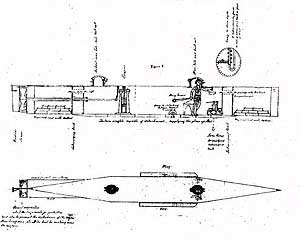
Figure 2. Another of the PRO drawings, this one showing the internal plan view of the boat and a transverse cross-section at the aft face of the forward bulkhead. “The pilot is represented looking through a bull’s eye, his right hand on the vertical steering control, and his left on the lever for working an ordinary stern rudder… The depth being constantly indicated on an ordinary mercurial siphon gauge fixed immediately opposite the pilot–one end of which is open to the outside water–each 1/2 inch of mercury represents about one foot of immersion.” (PRO Adm. Ser. 1/6236, File 39455)
Enclosed with their intelligence summary were copies of McClintock’s letters of endorsement from former Confederate officers Matthew F. Maury, James E. Slaughter, J.D. Johnstone, Raphael Semmes, and P. Murphey. But perhaps the most valuable piece of historical evidence is the four page narrative, written in McClintock’s own hand, describing the construction of the three boats he designed and saw built during the war.
McClintock, Watson, their Coalition of Supporters, and their Boats
The core of the submersible boat building program that ultimately produced Pioneer, American Diver, and H.L. Hunley was formed by a coalition of New Orleans machinists and businessmen probably motivated by both nationalistic feeling and the possibility of collecting prize money for the destruction of enemy vessels of war. The initial New Orleans group consisted of machinists (or “practical engineers”) Baxter Watson and James McClintock, lawyer and Deputy Collector of Customs Horace L. Hunley, customs house employee and diver John K. Scott, Hunley’s wealthy brother-in-law Robert Ruffin Barrow, and prominent lawyer and newspaper editor Henry J. Leovy. These six men were the driving force behind the Pioneer‘s construction over the winter of 1861-1862 at the Leeds Foundry, near the Government Yard at New Basin. While the composition of this group would evolve somewhat over the next several years, it would be McClintock and (until his death) Hunley who would remain at its core.
The First Attempt: Pioneer
The effort to construct Pioneer was possibly alluded to as early as 17 August 1861 in the New Orleans Daily Delta (Kloeppel 1992, 6). Leovy was likely the source of these rumors, as he was on the Daily Delta‘s editorial staff. Their submersible was floated in February 1862 at the government yard at New Basin, taken up the New Canal, and reportedly underwent trials in Lake Ponchartrain. McClintock later described the first of his three boats as being built:
…in New Orleans in 1862, of iron 1/4 inch thick, 30 feet long, 4 feet in diameter with cone ends 10 feet long, with a propeller in one end, turned with a crank by two (2) persons inside of the boat. This boat was faulty in shape. Yet it demonstrated the fact that a boat could be built, that would move at the will of the operator in any direction required, and at any distance from the surface of the water. The evacuation of New Orleans occurred before all our experiments were completed (McClintock Narrative, PRO, Adm. Series 1/6236, File 39455).
According to a letter written in 1871 by McClintock to fellow Confederate underwater warfare specialist Matthew Fontaine Maury, during this shakedown the boat sank a schooner and two target barges by means of a towed torpedo (Perry 1965, 95; Kloeppel 1987, 6-9). On 29 March 1862 application was made by John K. Scott for a letter of marque and reprisal as a privateer, which was issued to the Pioneer by Hunley’s supervisor, Collector F.H. Hatch on March 31 under the authorization of C.S. Secretary of State Judah P. Benjamin (also a New Orleans lawyer and acquaintance of Leovy’s). The letter of marque records the vessel’s name as Pioneer, and the vessel type as a “submarine propeller” armed with a “magazine of powder.” The Pioneer is described as measuring 34 feet in overall length, 4 feet in beam, drawing 4 feet of water, and weighing 4 tons. It was painted black and had “round conical ends.” To obtain the letter of marque a surety of $5,000.00 was posted by Hunley and Leovy (ORN I, 9, 399-400). The number of crew required is listed as three, with John K. Scott as the vessel commander (the choice of Scott as vessel commander may have been dictated by not only his presumed piloting ability, but also his experience as a diver, which is alluded to by correspondence appearing in ORN II, 1, 556). The Pioneer never saw action, for less than a month later New Orleans fell the combined U.S. forces under Flag Officer David G. Farragut, USN and General Benjamin F. Butler, USA as part of the combined campaign to take the Mississippi River Valley from Head of the Passes to Cairo and divide the Confederacy in half. Most likely sometime between 24 and 28 April 1862, with Farragut and Butler at the city gates, possibly while the levee front and shipyards were ablaze in the destruction of any goods of material value to the enemy, an attempt was made by Pioneer‘s builders to conceal it somewhere in the vicinity of the New Basin. At least three of the group, McClintock, Watson, and Hunley, fled to Mobile, Alabama with the intention of building an improved vessel there.
During the subsequent Federal occupation of New Orleans, the Pioneer was discovered and a study of its construction was made by U.S. Navy Lieutenants Alfred Colin and George W. Baird of the USS Pensacola‘s engineering department. Colin and Baird forwarded their study to the fleet engineer (Baird 1902, 845-846). In 1868 the Pioneer was sold for scrap at a public auction held before the New Orleans Customs House (New Orleans Picayune, 15 February 1868, morning and afternoon editions). There has existed a great deal of speculation regarding the dimensions and configuration of this Hunley predecessor, as well as whether or not a submersible recovered from a canal connected to Lake Ponchartrain in July 1878 (Scharf 1887, 761) and presently located at the Louisiana State Museum may in fact constitute the remains of Pioneer (Robinson 1928, Arthur 1947, Kloeppel 1989; Wills 1994, Luraghi 1996). Fortunately, within the last year the surviving records of Colin and Baird’s documentation have been located and brought to light by historical researcher Mark Ragan (“Letters received by the Secretary of the Navy from Officers below the Rank of Commander, 1802-1884,” NARA, RG 45, Entry M148). The documentation uncovered by Ragan includes a drawing of the boat (Figure 3), conclusively revealing that the Louisiana State Museum Vessel is not the Pioneer. This lends further potential credence to a theory recently proposed by researcher Francis Chandler Furman which suggests that the Louisiana State Museum vessel may in fact be one of the submersibles reportedly constructed at the Tredegar Iron Works (Coski 1996, 292 ff). If this is the case, its minuscule size may indicate a purpose as a builder’s scale working prototype (Pinkerton 1888, 400) which may have been sent to New Orleans through Edward M. Ivens, Tredegar’s New Orleans agent (ORN II, 1, 533) as a model to assist in the construction of larger such vessels to be built at Confederate Navy Department facilities there and elsewhere (ORN I, 9, 411-412; I, 22, 103-105).
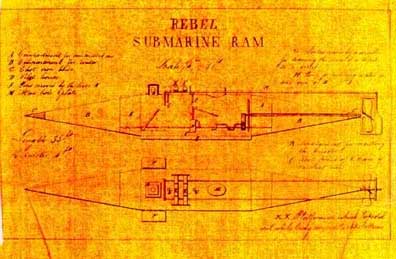
Figure 3. The “Rebel Submarine Ram “documented by Lieutenants Colin and Baird. It is undoubtedly the Confederate Privateer Pioneer. This drawing and its accompanying documentation, uncovered by researcher Mark Ragan, provides definitive proof that the Louisiana State Museum vessel is not McClintock and Watson’s privateer Pioneer, as previously thought by some.
The Second Attempt: American Diver
Upon arriving in Mobile, McClintock, Watson, and Hunley were joined in their efforts by engineers Thomas Park and Thomas Lyons of the Park & Lyons machine shops, who provided their facilities for the fabrication of a new boat. The group also now began to receive support from the military in the form of Lieutenant William Alexander, CSA, an engineer temporarily detached from the Twenty-First Alabama Volunteer Regiment and detailed to duty at Park & Lyons. According to information from a Confederate deserter who had worked in the Mobile shop around this time, upon completion their resulting vessel was referred to as American Diver (ORN I, 15, 229). In a letter to Matthew Fontaine Maury written after the war, McClintock recorded that the original intention was to build a boat capable of mechanical self-propulsion:
To obtain room for the machinery and persons, she was built 36 feet long, 3 feet wide, and 4 feet high, 12 feet at each end was built tapering or modeled to make her easy to pass through the water. There was much time and money lost in efforts to build an electromagnetic engine for propelling the boat…I afterwards fitted cranks to turn the propeller by hand, working four men at a time, but the air being so closed, and the work so hard, that we were unable to get a speed sufficient to make the boat of service against vessels, blockading the port (Maury Papers, Library of Congress; cited in Ragan 1995, 22, 24).
Not long thereafter, McClintock provided more detail in the narrative he gave to officers of the Royal Navy during his secret meeting at Halifax. He wrote that:
In 1863 I built the second boat, also of iron 1/4 inch thick, and in order to obtain more room as well as to correct the faults of the first boat, she was built with square sides. Dimensions was 36 feet long, 4 feet high, and 3 feet across top & bottom, with ends tapered like a wedge for a model, with a 30 inch propeller in the end. I spent much time and money in efforts to work an Electro Magnetic Engine, but without success. I afterwards fitted her up with cranks, to be turned by four men. But her speed was not sufficient to make her of service against blockaders, they being six miles at sea (McClintock Narrative, PRO, Adm. Series 1/6236, File 39455).
The origin of the American Diver‘s electromagnetic engine remains obscure, and as a result it has been the subject of much conjecture. McClintock may have initially been influenced by several descriptions of electromagnetic engines which appeared in the British technical publication The Engineer (11 May 1860, 309; 29 March 1861, 201; 4 April 1861, 216; 5 September 1862, 148; 19 September 1862, 177). This seems a logical possibility in light of the fact that he later admitted that this same publication was the source of more detailed information regarding an ammoniacally-powered submarine proposed by him to the Royal Navy. Records indicate that during the second boat’s construction, Admiral Franklin Buchanan, CSN informed Secretary of the Navy Stephen Mallory that “within the last week or ten days we succeeded in getting a man from New Orleans who was to have made the `magnetic engine’ by which it was to have been propelled” (Kloeppel 1995, 24). This “man from New Orleans” may have been the “Frenchman” referred to in other correspondence, and may have in fact been the mysterious figure named Anstilt (or Alstitt) (Schell 1992, 168-171). At this same time in Mobile in 1863, an electric-powered vessel attributed to Anstilt, sometimes referred to as the American Ram, was also purportedly under construction. A somewhat fanciful sketch of this alleged boat appeared in Harper’s Illustrated Weekly of 10 June 1864. Sources regarding this vessel are extremely sketchy, and it seems likely that they may actually have been referring to the American Diver, perhaps confusing Anstilt’s proposed designs and propulsion experiments with his possible work with the McClintock group at Park & Lyons (Schell, 1992, 169-171). Unfortunately, when it became apparent that the electromagnetic engine was incapable of providing the amount of power required, it was removed and a small, custom-built steam plant was installed in its place. However, this powerplant was also determined to be unusable and likewise was removed (Ragan 1995, 22).
Significantly, the records from the PRO documenting McClintock’s 1872 visit to Halifax include a three-view sketch of a submersible, drawn by Captain Nicholson in the presence of McClintock (see Figures 1 and 2, above). While the dimensions and configuration of all three of McClintock’s boats are detailed in the accompanying written report, the boat represented in the sketch appears to possess features of both the second and third boats. Some of these discrepancies are acknowledged and explained in the accompanying text. Nicholson and Ellis recorded that “the drawing we enclose is a representation of the boat that effected this destruction [of Housatonic], it is not drawn to scale, nor did the original boat contain any engine, the only motive power then available being manual labor…(“Report of a submarine boat built by Mr. McClintock of Mobile, U.S. of America,” PRO Adm. Series 1/6236, File 39455). It seems significant that the PRO drawings bear a close resemblance to the vessel represented in a postwar drawing by Baird which was made in the presence of, and based upon information provided by, McClintock (Figure 4). Baird, apparently assuming that McClintock built only one boat in Mobile, subsequently identified the boat in this drawing as “the vessel that destroyed the U.S.S. Housatonic” (Baird 1902, 846). Because of this, it has been commonly assumed that he was attempting to represent the Hunley, when in fact what McClintock may have actually been describing to him was the American Diver. In a response to Baird’s article written shortly after it appeared, Alexander raised an objection to this identification, noting of the drawing in question that “after the capture of New Orleans McClintock went to Mobile and built the submarine in Plate I. I don’t know where McClintock is living, but hope he will assist in correcting this error” (Ragan 1995, 25). Unfortunately, McClintock was never able to correct the record; he was long since dead by this time, having been killed in Boston Harbor in 1879 in an accidental explosion while demonstrating the use of some of his underwater contact mine designs for the government (Ragan 1995, 164). But while McClintock did not survive long enough to answer Alexander’s request, the PRO drawings seem to reinforce the accuracy of his memory in regard to the configuration of his second boat, left behind in the form of his letter to Maury and his description as relayed to Baird. One interpretation of the newly uncovered PRO written descriptions and drawings may be that they may suggest a much closer relationship in design between McClintock’s second and third boats than has previously been suspected.
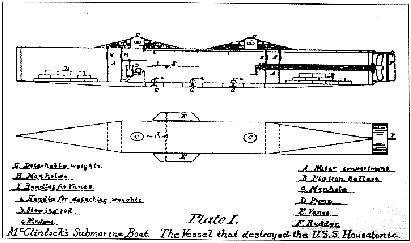
Figure 4. Diagram of a submarine boat drawn by Rear Admiral Baird in McClintock’s presence. Baird has labeled this as “The Vessel that destroyed the U.S.S. Housatonic.” Alexander subsequently stated in a letter to the Navy that this identification was in error, and that the sketch represented not the Hunley but the first boat built in Mobile.
The American Diver was floated in Mobile Bay in February of 1863. It was towed off Fort Morgan with the intention of manning it there and attacking the Federal fleet, but as the weather grew worse and the sea became rough, the boat became difficult to manage and foundered. No lives were lost in this mishap, but the Confederate submariners had been deprived of another vessel in which they had invested much effort, time, and funding.
The Third Attempt: H.L. Hunley
McClintock and Hunley’s group would not be discouraged. Financially strapped, they sold shares in the third venture to members of the Singer Submarine Corps, composed of engineers E.C. Singer, B. Gus Whitney, R.W. Dunn, and J.D. Breaman (Duncan 1965, 64). Hunley held one third of the shares, Singer one third, and the last third was split among Whitney, Dunn, and Breaman (Ragan 1995, 26). It may have been at this early stage of the boat’s construction that Lieutenant Alexander was joined by another Army assignee to this detail, his friend Lieutenant George Dixon, CSA, also of the 21st Alabama (Dixon, it should be noted, was actually a Kentuckian, while Alexander was British, having emigrated to America only several years previously). Dixon and Alexander were veterans of Shiloh, and Dixon is known to have sustained a serious leg wound there (Ragan 1995, 28). The group obtained a long cylindrical steam boiler which the engineers lengthened, deepened, and fitted out to accommodate a maximum crew of nine. Whether the steam boiler used originated from a steamship, railroad engine, or other source remains unclear; further research into boiler design, construction, and configuration may provide an answer.
The boat was launched in July 1863 at Mobile’s Theater Street dock. At this early point before Hunley’s asphyxiation and the subsequent naming of the vessel for him, this vessel may have been referred to by several different names, including “the Fish Boat” (Fort 1914; Stanton 1914), “the fish torpedo boat” (Beauregard 1878, 152), and “the Porpoise” (Ragan 1995, 42). Trials produced pleasing results. Admiral Franklin Buchanan, CSN noted that the boat was capable of making four knots (Ragan 1995, 30). The attention of General P.G.T Beauregard, CSA was evidently captured by the method of illumination; he recorded that “light was afforded through the means of bull’s-eyes placed in the manholes” (Beauregard 1878, 153). McClintock described the boat as follows:
In the Spring of 1864 I built the 3d boat, having abandoned the artificial motive power as not attainable in our situations. I modeled her, and built expressly for hand power. This boat was of an elliptic shape, with modeled ends, and looked similar to surf, or whale boats, placed one on top of the other. She was built of iron 3/8 inch thick, 40 feet long top & bottom, 42 inches wide in the middle, & 48 inches high, fitted with cranks geared to her propeller & turned by 8 persons inside of her. And although she was a beautiful model boat, and worked to perfection just like her predecessors, the power was too uncertain to admit of her venturing far from shore. This boat was taken to Charleston, SC, and destroyed the sloop of war Housatonic. Myself nor the Sub Marine’s gallant commander who lost his life in demonstrating her [illegible, possibly “success”] considered there was any danger in going out and destroying any vessel, but the danger was in having sufficient power to bring the boat back (McClintock Narrative, PRO, Adm. Series 1/6236, File 39455).
Interestingly, McClintock’s statement regarding “cranks geared to her propeller” may indicate that the drive train included a reduction gear. A similar such feature is present in the construction of the U.S. Navy’s Intelligent Whale (personal communication, Peter Hitchcock to Richard Wills, 1996).
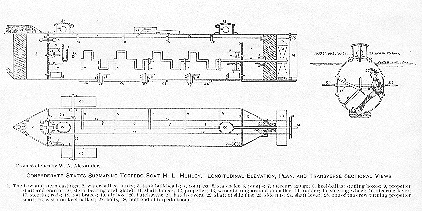
Figure 5. Diagram of the H. L. Hunley, drawn by William A. Alexander, showing the boat’s longitudinal elevation plan view, and a transverse section. Alexander’s numbers represent the following features: (1) the bow and stern castings; (2) water-ballast tanks; (3) tank bulkheads; (4) compass; (5) sea cocks; (6) pumps; (7) mercury gauge; (8) keel-ballast stuffing boxes; (9) propeller shaft and cranks; (10) stern bearing and gland; (11) shaft braces; (12) propeller; (13) wrought ring around propeller; (14) rudder; (15) steering control; (16) steering lever; (17) steering rods; (18) rod braces; (19) air box; (20) hatchways; (21) hatch covers; (22) shaft of side fins; (23) side fins; (24) shaft lever; (25) one of the crew turning propeller shaft; (26) cast-iron keel ballast; (27) bolts; (28) butt end of torpedo boom.
Years after the war, Alexander made a sketch of the third vessel’s construction (Figure 5) and described the boat as follows:
We decided to build another boat, and for this purpose took a cylinder boiler which we had on hand, 48 inches in diameter and twenty-five feet long (all dimensions are from memory). We cut this boiler in two, longitudinally, and inserted two 12-inch boiler-iron strips in her sides, lengthened her by one tapering course fore and aft, to which were attached bow and stern castings, making the boat about 30 feet long, 4 feet wide and 5 feet deep. A longitudinal strip 12 inches wide was riveted the full length of the top. At each end a bulkhead was riveted across to form water-ballast tanks (unfortunately these were left open on top); they were used in raising and sinking the boat. In addition to these water tanks the boat was ballasted by flat castings, made to fit the outside bottom of the shell and fastened thereto by “Tee” headed bolts passing through stuffing boxes inside the boat, the inside of the bolt squared to fit a wrench, that the bolts might be turned and the ballast dropped, should the necessity arise. In connection with each of the water tanks there was a sea-cock open to the sea to supply the tank for sinking; also a force pump to eject water from the tanks into the sea for raising the boat to the surface. There was also a bilge connection to the pump. A mercury gauge, open to the sea, was attached to the shell near the forward tank, to indicate the depth of the boat below the surface. A one and a quarter shaft passed through stuffing boxes on each side of the boat, just forward of the end of the propeller shaft. On each side of this shaft, outside of the boat, castings, or lateral fins, five feet long and eight inched wide, were secured. This shaft was operated by a lever amidships, and by raising or lowering the needs of these fins, operated as the fins of a fish, changing the depth of the boat below the surface at will, without disturbing the water level in the ballast tanks.The rudder was operated by a wheel, and levers connected to rods passing through stuffing-boxes in the stern castings, and operated by the captain or pilot forward. An adjusted compass was placed in front of the forward tank. The boat was operated by manual power, with an ordinary propeller. On the propelling shaft there were formed eight cranks at different angles; the shaft was supported by brackets on the starboard side, the men sitting on the port side turning the cranks. The propeller shaft and cranks took up so much room that it was very difficult to pass fore and aft, and when the men were in their places this was next to impossible. In operation, one- half the crew had to pass through the fore hatch; the other through the after hatchway. The propeller revolved in a wrought iron ring or band, to guard against a line being thrown in to foul it. There were two hatchways – one fore and one aft — 16 inches by 12, with a combing 8 inches high. These hatches had hinged covers with rubber gasket, and were bolted from the inside. In the sides and ends of these combings glasses were inserted to sight from. There was an opening made in the top of the boat for an air box, a casting with a close top 12 by 18 by 4 inches, made to carry a hollow shaft. This shaft passed through stuffing boxes. On each end was an elbow with a 4 foot length of 1 1-2 inch pipe, and keyed to the hollow shaft; on the inside was a lever with a stop-cock to admit air (Alexander 1902).
It was decided that the boat should be shipped by flatcar to Charleston, South Carolina for anti-blockade duty under the command of General P.G.T. Beauregard, CSA. Whereas Mobile’s defenses were well fortified, Charleston was suffering under a siege of more serious proportions. Charleston’s coastal waters may also have presented a more desirable operating environment, especially in terms of providing greater depth. Furthermore, General Beauregard in Charleston looked favorably upon unconventional weapons, while General Dabney H. Maury and Admiral Franklin Buchanan in Mobile may not have been so willing to embrace such unproven forms of naval warfare. Finally, the move was undoubtedly encouraged by the high bounties being placed upon the naval vessels of the South Atlantic Blockading Squadron. The result was that the submersible was shipped to Charleston by flatcar in August 1863. In a letter “inflicted” upon his fiancé, Lieutenant George Gift, CSN of the CSS Gaines described how he had “been employed during the past day or two in hoisting out of the water and sending away toward Charleston a very curious machine for destroying vessels” which he describes as follows:
In the first place imagine a high pressure steam boiler, not quite round, say 4 feet in diameter in one way and 3-½ feet the other — draw each end of the boiler down to a sharp wedge shaped point. The 4 feet is the depth of the hold and the 3-½ feet the breadth of beam. On the bottom of the boat is riveted an iron keel weighing 4000 lbs which throws the center of gravity on one side and makes her swim steadily that side down. On top and opposite the keel is placed two man hole plates or hatches with heavy glass tops. These plates are water tight when covered over. They are just large enough for a man to go in and out. At one end is fitted a very neat little propeller 3-½ feet in diameter worked by men sitting in the boat and turning the shaft by hand cranks being fitted on it for that purpose. She also has a rudder and steering apparatus.Embarked and under ordinary circumstances with men ballast &tc she floats about half way out of the water & resembles a whale. But when it is necessary to go under the water there are apartments into which the water is allowed to flow, which causes the boat to sink to any required depth, the same being accurately indicated by a column of mercury. Air is supplied by means of pipes that turn up until they get below a depth of 10 feet, when they must depend upon the supply carried down which is sufficient for 3 hours! During which time she could have been propelled 15 miles!
Behind the boat at a distance of 100 to 150 feet is towed a plank and under that plank is attached a torpedo with say 100 lb of powder. The steersman has a string by which he can explode the torpedo by giving it a jerk. I saw them explode a vessel as an experiment. They approached within about fifty yards of her keeping the man holes just above water. At that distance she the submarine sank down and in a few minutes made her appearance on the other side of the vessel. He pulled the string and smashed her side to atoms…(Turner 1995, 5-8).
Alexander later indicated that this towed torpedo arrangement proved unworkable, recording that:
The torpedo was a copper cylinder holding a charge of ninety pounds of explosive, with percussion and friction primer mechanism, set off by flaring triggers. It was originally intended to float the torpedo on the surface of the water, the boat to dive under the vessel to be attacked, towing the torpedo with a line 200 feet long after her, one of the triggers to touch the vessel and explode the torpedo, and in the experiments made in the smooth water of Mobile River on some old flatboats these plans operated successfully, but in rough water the torpedo was continually coming too near the wrong boat. We then rigged a yellow pine boom, 22 feet long and tapering; this was attached to the bow, banded and guyed in each side. A socket on the torpedo secured it to the boom (Alexander 1902).
As can be seen from some of the previous accounts, the dimensions of Hunley vary somewhat depending on which historical source is consulted. When put into a table form alongside the dimensions recorded for McClintock’s other boats, and compared to reliable documented measurements, it may be possible to draw some conclusions regarding the relative accuracy of these dimensions (Figure 6). McClintock’s descriptions of circa 1871 and 1872 descriptions emerge as being consistently near the mark, if not perhaps slightly conservative as in the case of Pioneer. Gift is not far off, while Alexander (who in all fairness cautioned 40 years after the fact that “all dimensions are from memory”) seems to be somewhat further off the mark.
Sometime during its operations in Charleston, the boat became the object of an artistic study by the famed artist Conrad Wise Chapman. Chapman has left us two informative depictions of the boat: his pencil study and his finished oil portrait (Figure 7).
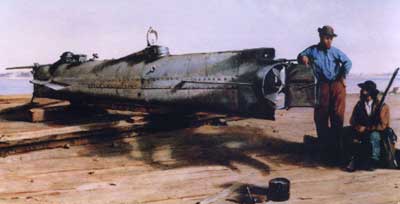
Figure 7. Conrad Wise Chapman’s famous oil painting of the Hunley.
Following its arrival in South Carolina, the boat experienced a number of operational difficulties. The Army became increasingly unhappy with McClintock’s management of the boat, and as a result seized it, replacing the civilian crew with C.S. Navy personnel. It was following this transition that the boat was twice accidentally lost in Charleston Harbor with fatalities, being both times subsequently salvaged. The first incident killed five members of the crew of nine, most of whom were volunteers from the CSS Chicora and CSS Palmetto State. Lieutenant C.L. Stanton, CSN provides the background of this misfortune.
One day when Lieutenant Payne, my friend and shipmate, was aboard the Chicora I arranged to go down under the water with him; but as the boat was obliged to leave before my watch on deck was over, Lieutenant Charles H. Hooker [sic, he means Hasker] took my place. She dived about the harbor successfully for an hour or two and finally went over to Fort Johnson, where the little steamer Etiwan was lying alongside the wharf. She fastened to her side with a light line with the fins in position for diving… (Stanton 1914).
Lieutenant Charles H. Hasker, CSN (a former U.S. Navy hand who had been the boatswain on the CSS Virginia during the Battle of Hampton Roads) was sitting immediately behind Payne in the lead cranksman’s position at the time of the accident, and related the following experience:
We were lying astern of the steamer Etowah [one of several names by which the CSS Etiwan was known], near Fort Johnson, in Charleston Harbor. Lieutenant Payne, who had charge, got fouled in the manhole by the hawser and in trying to clear himself got his foot on the lever which controlled the fins. He had just previously given the order to go ahead. The boat made a dive with the manholes open and filled rapidly. Payne got out of the forward hole and two others out of the aft hole. Six of us went down with the boat. I had to get over the bar which connected the fins and through the column of water which was rapidly filling the boat. The manhole plate came down on my back; but I worked my way out until my left leg was caught by the plate, pressing the calf of my leg in two. Held in this manner, I was carried to the bottom in forty-two feet of water. When the boat touched bottom I felt the pressure relax. Stooping down, I took hold of the manhole plate, drew out my wounded limb, and swam to the surface. Five men were drowned on this occasion (Fort 1914).
Payne and Hasker escaped the forward hatch, while the team’s explosives expert, Charles L. Sprague, and another unidentified crewmember managed to fight their way out through the aft coaming. Carried to the bottom and drowned were sailors Frederick (Frank) Doyle, John Kelly, Nicholas (Nick) Davis, and Michael Kane (or Cane) of the Chicora, and Absolum Williams of the Palmetto State (Ragan 1995, 54). Following this tragedy, the military sent a request to Mobile asking for people more familiar with the boat to come to Charleston to take over its operation upon its recovery. Horace Hunley, Thomas Park’s son Thomas W. Park (often misidentified as his father), and approximately six or so other volunteers, probably mechanics from the Park & Lyons shop, answered the call, journeyed to Charleston, and spent some time putting the boat through “diving and raising” tests, possibly for the purpose of testing a new adjusted compass (Ragan 1995, 66). When it finally appeared to observers that all the vessel required was experienced hands, the boat suffered another terrible disaster. While running submerged, Hunley, acting as vessel commander, made a simple error in regulating the water contained within the forward ballast tank, and the boat buried its bow in the harbor mud, stuck fast, and partially flooded, killing the entire crew of eight. In addition to Hunley, Park, and the stout-hearted Sprague, this crew contained Mobilians Robert Brockbank, Charles McHugh, John Marshall, Henry Beard, and Joseph Patterson (who may be the individual identified as “White” in Alexander’s narrative). Even after the passage of nearly fifteen years, General Beauregard’s recollection of the events surrounding the recovery of the boat and crew three weeks after the sinking was still vivid when he set it to paper:
Lieutenant Dixon made repeated descents in the harbor of Charleston, diving under the naval receiving ship which lay at anchor there. But one day when he was absent from the city Mr. Hunley, unfortunately, wishing to handle the boat himself, made the attempt. It was readily submerged, but did not rise again to the surface, and all on board perished from asphyxiation. When the boat was discovered, raised and opened, the spectacle was indescribable and ghastly; the unfortunate men were contorted into all kinds of horrible attitudes; some clutching candles, evidently endeavoring to force open the man-holes; others lying on the bottom tightly grappled together, and the blackened faces of all presented the expression of their despair and agony. After this tragedy I refused to permit the boat to be used again; but Lieutenant Dixon, a brave and determined man, having returned to Charleston, applied to me for authority to use it against the Federal steam sloop-of-war Housatonic, a powerful new vessel, carrying eleven guns of the largest caliber, which lay at the time in the north channel opposite Beach Inlet, materially obstructing the passage of our blockade-runners in and out (Beauregard 1878, 153-154).
The divers hired to locate and rig the boat for salvage found it buried bow-first in the mud. Alexander’s insightful attempt to reconstruct the accident provides some detail of the crew’s standard operating procedures:
The position in which the boat was found on the bottom of the river, the condition of the apparatus discovered after it was raised and pumped out, and the position of the bodies in the boat, furnished a full explanation for her loss. The boat, when found, was lying on the bottom at an angle of about 35 degrees, the bow deep in the mud. The bolting-down bolts of each hatch cover had been removed. When the hatch covers were lifted considerable air and gas escaped. Captain Hunley’s body was forward, with his head in the forward hatchway, his right hand on top of his head (he had been trying, it would seem, to raise the hatch cover). In his left hand was a candle that had never been lighted, the sea-cock on the forward end, or `Hunley’s’ ballast tank, was wide open, the cockwrench not on the plug, but lying on the bottom of the boat. Mr. Park’s body was found with his head in the after hatchway, his right hand above his head. He also had been trying to raise the hatch cover, but the pressure was to great. The sea-cock to his tank was properly closed, and the tank was nearly empty. The other bodies were floating in the water. Hunley and Parks were undoubtedly asphyxiated, the others drowned. The bolts that held the iron keel ballast had been partly turned, but not sufficient to release it.In the light of these conditions, we can easily depict before our minds, and almost readily explain, what took place in the boat during the moments immediately following its submergence. Captain Hunley’s practice with the boat had made him quite familiar and expert in handling her, and this familiarity produced at this time forgetfulness. It was found in practice to be easier on the crew to come to the surface by giving the pumps a few strokes and ejecting some of the water ballast, than by the momentum of the boat operating on the elevate fins. At this time the boat was under way, lighted through the deadlights in the hatchways. He partly turned the fins to go down, but thought, no doubt, that he needed more ballast and opened his sea-cock. Immediately the boat was in total darkness. He then undertook to light the candle. While trying to do this the tank quietly flooded, and under great pressure the boat sank very fast and soon overflowed, and the first intimation they would have of anything being wrong was the water rising fast, but noiselessly, about their feet in the bottom of the boat. They tried to release the iron keel ballast, but did not turn the keys quite far enough, and therefore failed. The water soon forced the air to the top of the boat and into the hatchways, where captains Hunley and Parks were found. Parks had pumped his ballast tank dry, and no doubt Captain Hunley had exhausted himself on his pump, but he had forgotten he had not closed his sea cock (Alexander 1902).
McClintock’s caution with the boat may have been excessive, but in hindsight it seems to have been justifiable in light of the two tragedies which subsequently befell the boat. Both accidents seem to have been in some way attributable to personal errors on the part of the vessel commanders; in Payne’s case the result was that five of the crew drowned, whereas Hunley’s actions may have resulted in not only his own death but also his entire crew. In addition to these operational casualties, one of the boat’s investors, Gus Whitney, also died during this period, possibly from exposure related to the operations of the boat (Duncan 1965, 66).
Upon the salvage of the boat, Dixon and Alexander saw their fellow submariners buried in Charleston’s Magnolia Cemetery. The surviving members of the group memorialized Hunley’s efforts by naming the boat H.L. Hunley after him. Saddened but undaunted, Dixon and Alexander enlisted another volunteer crew, which ultimately came to include naval personnel James A. Wicks, Arnold Becker, C. Simkins, F. Collins, (first name unknown) Ridgeway, and (first name unknown) Miller, as well as Corporal C.F. Carlson, CSA, of Company A, South Carolina Light Artillery (Ragan 1995, 90, 126). The group moved their operations to Battery Marshall, on Sullivan’s Island, where between November 1863 and February 1864 they frequently fought foul weather to cast off on night cruises on the seas off Charleston. On 5 February, fate touched Alexander in the form of orders received to report to another project, and he reluctantly bid Dixon and the crew a farewell. He never saw his friends again. On 17 February, Corporal Donald W. McClaurin of Battery Marshall was summoned to the boat in order to make adjustments to the on-board machinery, during which time he made note of the Hunley‘s third and final torpedo configuration:
As I recall, the torpedo was fastened to the end of an iron pipe, about two inches in diameter and twenty to twenty-five feet in length, which could be extended in front and withdrawn at ease by guides in the center of the boat to hold it in place. Lieutenant Dixon landed and requested that two of my regiment, the 23rd South Carolina Volunteers, go aboard and help them to adjust the machinery, as it was not working satisfactorily. Another man and I went aboard and helped propel the boat for some time while the Lieutenant and others adjusted the machinery and the rods that held the torpedo and got them to working satisfactorily (Ragan 1995, 130).
The manner in which the spar was rigged has been the matter of some debate. Lieutenant Stanton recorded his views on this subject as follows:
Lieutenant Payne, although a willing volunteer for this dangerous service, never at any time had faith in the success of the enterprise. I heard him say time and again that if he struck a vessel with the torpedo staff projecting horizontally he feared the boat would enter the hole made by the explosion in the ship’s side, and the machinery would not be powerful enough to back the boat out before it was carried down by the wreck. His idea was that if the torpedo staff was lowered to an angle of forty-five degrees when the ship was struck the torpedo would explode near the keel, and the Fishboat’s bow, striking the solid planking of the ship, would recoil sufficiently to make the machinery effective in backing out of danger of being drawn down by the wreck. I have always felt very certain that the torpedo staff was in this position when the Housatonic was struck…Besides, when the boat lay alongside the Chicora on the night of 14th of February, I examined it closely…(Stanton 1914).
On that same day as Corporal McClaurin was helping to fine-tune the boat’s machinery, a recognition signal using a blue lamp was arranged between Dixon and the men of Battery Marshall for the purpose of guiding the boat back to port after dark:
The day of the night the perilous undertaking was accomplished, the little war vessel was taken to Breach Inlet. The officer in command [Dixon] told Lieutenant-Colonel Dantzler [in command of Battery Marshall] when they bid each other good-by, that if he came off safe he would show two blue lights (Cardozo 1866, 124, cited in Ragan 1995, 132).
On the evening of 17 February 1864, with Dixon at the helm, Hunley set out on patrol. Approximately two and a half miles off Charleston Bar, the Hunley observed and shaped a course for the screw sloop-of-war USS Housatonic, which lay at anchor on blockade duty. The Housatonic‘s lookout spotted the Hunley and voiced a warning, but the ship’s attempt to get underway was not timely enough to prevent contact and detonation. The Housatonic sank in approximately three minutes. The subsequently convened board of inquiry into the Housatonic‘s loss provides a good amount of detail regarding the Hunley‘s audacious attack. Acting Master John Crosby, who was the Officer of the Deck on that moonlit eight to twelve watch, related the following:
I took the deck at 8 P.M. on the night of February 17th. About 8:45 P.M. I saw something in the water, which at first looked to me like a porpoise, coming to the surface to blow. It was about 75 to 100 yards from us on our starboard beam. The ship heading northwest by west ½ west at the time, the wind two or three points on the starboard bow. At that moment I called the Quartermaster’s attention to it asking him if he saw anything; he looked at it through his glass, and said he saw nothing but a tide ripple in the water. Looking again within an instant I saw it was coming toward the ship very fast. I gave orders to beat to quarters slip the chain and back the engine, the orders being executed immediately (Ragan 1995, 136).
Lieutenant F.J. Higginson, the ship’s executive officer, recorded that upon hearing the alarm for general quarters:
I went on deck immediately, found the Officer of the Deck on the bridge, and asked him the cause of the alarm; he pointed about the starboard beam on the water and said “there it is.” I then saw something resembling a plank moving towards the ship at a rate of 3 or 4 knots; it came close alongside, a little forward of the mizzen mast on the starboard side. It then stopped, and appeared to move off slowly. I then went down from the bridge and took the rifle from the lookout on the horse block on the starboard quarter, and fired at this object. It had the appearance of a plank sharp at both ends; it was entirely on awash with the water, and there was a glimmer of light through the top of it, as though through a dead light (Ragan 1995, 136- 138).
The Housatonic‘s commanding officer, Captain Charles W. Pickering, stated that:
On reaching the deck I gave the order to slip, and heard for the first time it was a torpedo, I think from the Officer of the Deck. I repeated the order to slip, and gave the order to go astern, and to open fire. I turned instantly, took my double barreled gun loaded with buck shot, from Mr. Muzzey, my aide and clerk, and jumped up on the horse block on the starboard quarter which the first Lieutenant had just left having fired a musket at the torpedo. I hastily examined the torpedo; it was shaped like a large whale boat, about two feet, more or less, under water; its position was at right angles to the ship, bow on, and the bow within two or three feet of the ship’s side, about abreast of the mizzenmanst, and I supposed it was then fixing the torpedo on. I saw two projections or knobs about one third of the way from the bows. I fired at these, jumped down from the horse block, and ran to the port side of the Quarter Deck as far as the mizzen mast, singing out “Go astern Faster” (Ragan 1995, 136).
The ship’s Assistant Engineer, Mr. Mayer, related his experiences as follows:
The engine was immediately backed, and had made three or four revolutions when I heard the explosion, accompanied by a sound of rushing water and crashing timbers and metal. Immediately the engine went with great velocity as if the propeller had broken off. I then throttled her down, but with little effect. I then jumped up the hatch, saw the ship was sinking and gave the order for all hands to go on deck (Ragan 1995, 138).
Ensign Charles Craven also managed to lay down fire at the attacking vessel, recording that:
I heard the Officer of the Deck give the order “Call all hands to Quarters.” I went on deck and saw something in the water on the starboard side of the ship, about thirty feet off, and the Captain and the Executive Officer were firing at it. I fired two shots at her with my revolver as she was standing toward the ship as soon as I saw her, and a third shot when she was almost under the counter, having to lean over the port to fire it (Ragan 1995, 138).
The Housatonic took five of its crew to the bottom, including Ensign E.C. Hazeltine, Quartermaster John Williams, Fireman Second Class John Walsh, Landsman Theodore Parker, and Pickering’s erstwhile yeoman Charles O. Muzzey (Ragan 1995, 142). But a final toll was exacted in exchange for the submersible’s tactical victory. The Hunley and its crew never returned to Sullivan’s Island, even though the prearranged lamp signals were believed to have been received from Dixon’s crew and interpreted as a request for a light to guide them safely back into port (ORN I, 15, 335). The vanishing of the Hunley with all hands subsequently became one of the sea’s greatest mysteries, remaining unsolved until the wreck was definitively relocated in 1995 by archaeologists Ralph Wilbanks, Wes Hall, and Harry Pecorelli III of best-selling author Clive Cussler’s National Underwater & Marine Agency (NUMA). A number of theories have been put forward regarding when, where, and how the boat was lost. Alexander for a long time believed that Hunley had been caught in or beneath Housatonic as the Navy warship rapidly sank (Alexander 1902), this belief being based partially upon the incorrect observations of government divers. But upon hearing from authoritative Navy sources that these reports were not authentic, Alexander still continued to believe that the wreck must have nevertheless come to rest not far away, having like Housatonic rapidly settled five feet beneath the seabed. Alexander noted that an agreement existed between the crewmembers that if the boat should for any reason be unable to surface, “the sea cocks were to be opened and the boat flooded” in order to prevent the suffering of slow asphyxiation known to have been experienced by Hunley’s crew (Alexander 1903). It has been theorized that the agreement Alexander spoke of may have represented the romanticized interpretation of a practical last-ditch escape strategy, in which an attempt would be made to equalize the pressures on the hatch surfaces in order to allow the crew to open them and ascend from the wreck (Ragan 1995, 168).
It has also been conjectured that the boat succumbed to structural damage or crew injuries sustained as a result of the contact and explosion, or from the Housatonic‘s defending gunfire. While the potential effects of the detonation on the submersible’s hull integrity remain a question, it seems very likely that the Hunley did absorb some degree of projectile damage from small arms fire, in light of the degree of fire and the close range of the two vessels at the time the defending fire was laid down. The boat drew fire from a variety of light weapons, including Higginson’s rifle, Craven’s revolver, Pickering’s double-barreled shotgun (presumably fired at the conning towers, based upon his testimony), and possibly the musketry fire of several other lookouts. It seems feasible that Pickering’s spread of buckshot at the “two projections” may have provided a good chance for damage to occur to some of the deadlights, and perhaps even caused crew injury.
Another theory put forward to account for the boat’s disappearance is that swift seas and worsening weather prevented the exhausted crew from successfully regaining port, and ultimately caused their delicately balanced boat to founder. McClintock’s opinion, recorded in 1872, is as follows:
I would here state that I do not believe that the Sub Marine Boat was lost in the operation of destroying the Housatonic, but was lost in a storm which occurred a few hours after. I am aware that the Federals has made diligent search for her, and have made three different reports of having found her, yet no descriptions that I have ever heard are correct (McClintock Narrative, PRO, Adm. Series 1/6236, file 39455).
During the late 1950s researcher Louis Genella conducted research into the climatological conditions of the night of 17 February, 1864, and concluded that on the 17th tidal conditions in the vicinity of Fort Sumter were probably as follows (all times are local): high water occurring at 3:40 PM, low water occurring at 9:45 PM; beginning of ebb current occurring at 4:30 PM, maximum ebb occurring at 7:45 PM; and the beginning of flood current occurring at 10:50 PM (Letter, Chief, Tides & Currents Division, U.S. Coast Geodetic Survey, Department of Commerce to Louis J. Genella, 13 March 1958; in the Louis J. Genella Collection, Tulane University Library). The attack took place between approximately 8:45 and 9:00 PM. The time that the blue signal light was witnessed and answered by Battery Marshall may have been sometime around 9:30 PM, which is when a blue light was observed on the water near the assisting USS Canandaigua by Seaman Robert Flemming, who had climbed up into the rigging of the settling Housatonic (Ragan 1995, 139-140, 170).
It may be likely that the cause of the Hunley‘s loss was attributable to more than one of these factors. In addition to the question of combat-related damage, a number of other questions also remain unanswered. Were eight or nine crewmen aboard for the final mission? Is the crew still aboard, or did they manage to escape the boat only to be lost at sea? If they are still aboard, did any suffer injuries in the explosion and gunfire? Are the hatches still bolted from the inside, or are they merely resting in a closed position? Are all of the keel ballast elements present, or was there any attempt to jettison the keel ballast? Are the seacocks still shut, or was there any attempt to purposefully open them? Exactly how was the spar torpedo assembly rigged, and does any evidence of it remain? What is the identity of the third magnetic anomaly located during the 1996 National Park Service remote-sensing survey between the wrecks of the Hunley and Housatonic? Could it be an element of the Hunley‘s keel ballast, or perhaps the Housatonic‘s slipped anchor? Based upon Assistant Engineer Mayer’s testimony, the force of the detonation may have either disengaged or completely blown off the Housatonic‘s propeller. Could it be a portion of the Housatonic‘s drive train? These are only a few mysteries which await an answer.
In retrospect, the Confederate submersible operations, and specifically H.L. Hunley‘s successful engagement of Housatonic, had several significant effects on U.S. Navy operations. They acted as a powerful psychological warfare tool, causing fear among the squadrons, particularly within the South Atlantic Blockading Squadron following the Hunley‘s action. They caused expensive and logistically intensive modifications to Federal blockading strategies through causing heightened security in the vessels on station, requiring them to be ready to get underway at all times, and forcing them to be redeployed further offshore at night, which in the case of Charleston perhaps allowed a greater possibility for blockade runners to get through to that besieged port. Finally, they may have provided the impetus for accelerated Federal attempts to gather intelligence on such craft, conduct their own research, and develop similar weapons. But while such attempts had been underway as early as 1861, it was the H.L. Hunley‘s attack on the Housatonic that defined to the U.S. Navy the danger of the submersible torpedo craft in Southern waters, and demonstrated to the world the vast potential of the submersible vessel in future naval strategy.
References
Manuscript Collections
“Letters received by the Secretary of the Navy from Officers Below the Rank of Commander, 1802-1884,” National Archives and Records Administration, Record Group 45, Microfilm M148.
“Proceedings of the Naval Court of Inquiry, 26 February 1864, Case #4345,” National Archives and Records Administration. Record Group 45.
“Submarine Warfare” (Report on Intelligent Whale by Rear Admiral E.A. Inglefield, RN, 4 March 1872; report on Mr. McClintock’s Submarine Torpedo Boat by Captain F. Nicholson, RN and Chief Engineer J.H. Ellis, RN, with enclosures, 21 October 1872), Public Record Office (London, Great Britain), Admiralty Office Series 1/6236, File 39455,
Louis J. Genella Collection (M-64), Manuscripts Department, Tulane University Library. Letter, Chief, Tides & Currents, U.S. Coast Geodetic Survey, Department of Commerce to Louis J. Genella, 13 March 1958.
Matthew Fontaine Maury Papers, Manuscript Division, Library of Congress, volume 46, items 9087-9094. Undated letter from James McClintock to Matthew F. Maury, ca. 1871.
Eustace Williams Collection, Woodruff Library Special Collections, Emory University Library. Transcript of a talk given by William A. Alexander to the Iberville Historical Society, Mobile, Alabama, 15 December 1903.
Published Sources
Abbot, Henry L. The Beginning of Modern Submarine Warfare under Captain Lieutenant David Bushnell. Archon Books, Hamden, Connecticut, 1966.
Alexander, William A. “The True Stories of the Confederate Submarine Boats,” New Orleans Picayune, 29 July 1902.
Arthur, Stanley C. “Pioneer: The First Submarine Boat Now on Exhibition in Jackson Square, New Orleans,” Alabama Historical Quarterly 9 (Fall 1947) 405-410.
Baird, G.W. “Submarine Torpedo Boats,” Journal of the American Society of Naval Engineers 14.2 (1902) 845-855.
Cardozo, J.N. Reminisces Charleston. Joseph Walker, Charleston, 1886. Cited in Ragan.
Coski, John M. Capital Navy: The Men, Ships, and Operations of the James River Squadron. Savas Woodbury Publishers, Campbell, California, 1996.
De Kay, James Tertius. The Battle of Stonington: Torpedoes, Submarines, and Rockets in the War of 1812. Naval Institute Press, Annapolis, 1990.
Dew, Charles B. Ironmaker to the Confederacy: Joseph R. Anderson and the Tredegar Iron Works. Yale University Press, New Haven and London, 1966.
Dudley, William S. (ed.). The Naval War of 1812: A Documentary History Volume 2 (1813). Naval Historical Center, Washington D.C., 1992.
Duncan, Ruth H. The Captain and Submarine CSS H.L. Hunley. S.C. Toof & Company, Memphis, 1965.
The Engineer. “Apparatus for applying and using mechanism for electromagnetism as a motive power” (11 May 1860, 309); “Electromagnetic engines” (29 March 1861, 201); “Class 1 Prime Movers: Electromagnetic engine for obtaining and applying power” (4 April 1862, 216); “Electromagnetic engine” (5 September 1862, 148); “Electromagnetic motive power engine” (19 September 1862, 177).
Field, Cyril. The Story of the Submarine from the Earliest Ages to the Present Day. Sampson Low, Marston & Company, London, 1908.
Fort, W.B. “First Submarine in the Confederate Navy,” Confederate Veteran 22 (1914) 459.
Gruse Harris, Patricia A. Great Lakes’ First Submarine: L.D. Phillips’ Fool Killer. Michigan City Historical Society, Michigan City, Indiana, 1982.
Harper’s Illustrated Weekly. “A Rebel Infernal Machine.” 2 November 1861, 701; 10 June 1864.
Hutcheon, Wallace S., Jr. Robert Fulton, Pioneer of Undersea Warfare. Naval Institute Press, Annapolis, 1981.
Kloeppel, James. “The Mystery Sub of Jackson Square,” Civil War Times Illustrated 28 (September/October 1989) 20-22.
Kloeppel, James. Danger Beneath the Waves: A History of the Confederate Submarine H.L. Hunley. Sandlapper Publishing, Inc, Orangeburg, South Carolina, 1992.
Lundeberg, Philip K. Samuel Colt’s Submarine Battery: The Secret and the Enigma (Smithsonian Studies in History and Technology Number 29). Smithsonian Institution Press, Washington D.C., 1974.
Luraghi, Raimondo. A History of the Confederate States Navy. Naval Institute Press, Annapolis, Maryland, 1996.
Morgan, William J. (ed). Naval Documents of the American Revolution Vol. 6. Department of the Navy, Naval History Division, Washington, D.C., 1972.
New Orleans Daily Delta. 17 August 1861.
New Orleans Picayune. 15 February, 1868. Morning and afternoon editions.
Parsons, William B. Robert Fulton and the Submarine. Columbia University Press, New York, 1922.
Perry, Milton F. Infernal Machines: The Story of Confederate Submarine and Mine Warfare. Louisiana State University Press, Baton Rouge, 1965.
Pinkerton, Allan. The Spy of the Rebellion. Kansas City Publishing Company, Kansas City, 1888.
Ragan, Mark. Submarines, Sacrifice, & Success in the Civil War. Narwhal Press Inc., Charleston, 1995.
Robinson, William M., Jr. The Confederate Privateers. Yale University Press, New Haven, 1928.
Roland, Alex. Underwater Warfare in the Age of Sail. Indiana University Press, Bloomington, 1978.
Scharf, J. Thomas. History of the Confederate States Navy. Joseph McDonough, Albany, 1887.
Schell, Sidney H. “Submarine Weapons Tested at Mobile During the Civil War,” The Alabama Review 54.7 (July 1992) 163-183.
Stanton, C.L. “Submarines and Torpedo Boats,” Confederate Veteran 22 (April 1914) 398-399. (Transcript on file at The Mariner’s Museum Research Library, Newport News, Virginia, dated 1966).
Turner, Maxine. “The Hunley: A Very Curious Machine,” The Confederate Naval Historical Society Newsletter 16 (July 1995) 5-8.
U.S. Department of the Navy, Office of Naval War Records. Official Records of the Union and Confederate Navies in the War of the Rebellion. Government Printing Office, Washington, D.C., 1901.
Wills, Richard. “The Confederate Privateer Pioneer and the Development of Confederate Submersible Watercraft,” The Institute of Nautical Archaeology Quarterly 21 (Spring/Summer 1994) 12-19.
Photos
Here you’ll find a wide range of photos related to the search for and subsequent discovery of the C.S.S. HUNLEY.
Recovery Photos
HUNLEY Found by NUMA on May 3, 1995
Photos by crew member Ralph Wilbanks
|
|
|
||||||
|
|
|
||||||
|
|
|
||||||
|
|
|||||||
|
|
|
||||||
|
|
|||||||
Miscellaneous Photos
|
|
|
||||||
|
|
|
||||||
|
|
|
||||||
Raising the Hunley Video Stills
|
|
|
||||||
|
|
|
||||||
|
|
|
||||||
|
|
|
Video Footage
These videos require the use of the Apple QuickTime Player (available for both PC and Macintosh computers). If you don’t already have Apple QuickTime loaded, please click HEREto download a player for your computer.
In this video produced by Oceaneering International, Inc., with the support of the Department of Defense Legacy Resources Management Program, you can see how the CSS HUNLEY was lifted from her watery grave. Computer animation in this video is by Mike Skrab.
Due to prohibitive file sizes, you can download the video in four separate parts (files 1 through 4) or as a single file if you have time and lots of bandwidth. Select any option that would work best for you.
|
|
All Rights Reserved © | National Underwater and Marine Agency
All Rights Reserved © | National Underwater and Marine Agency
Web Design by Floyd Dog Design
Web Design by Floyd Dog Design

